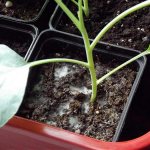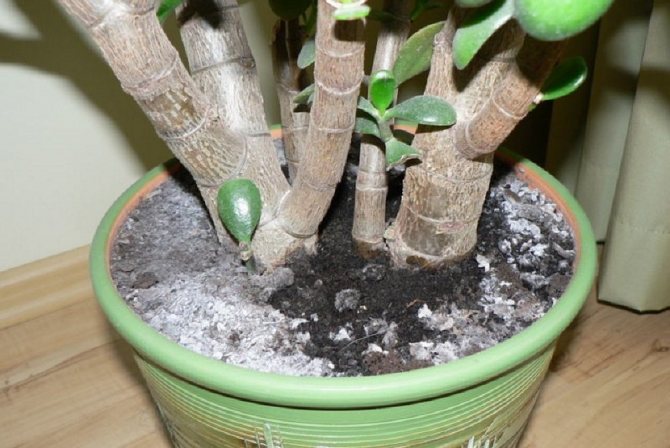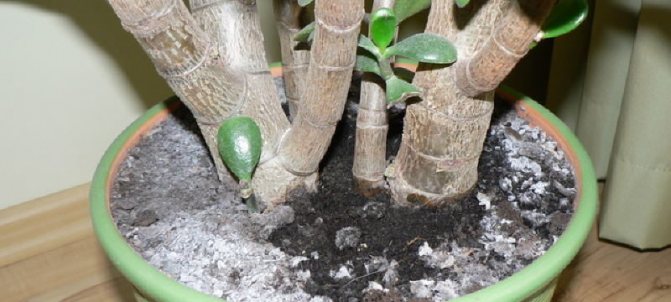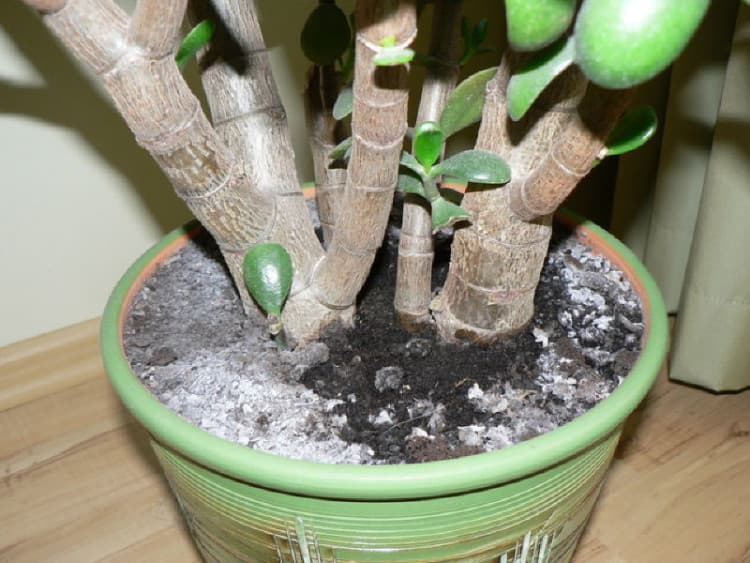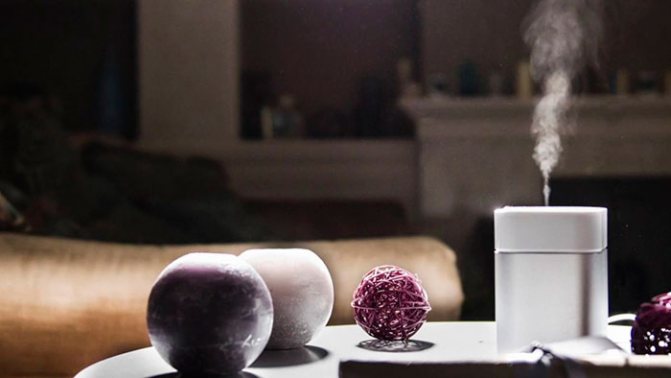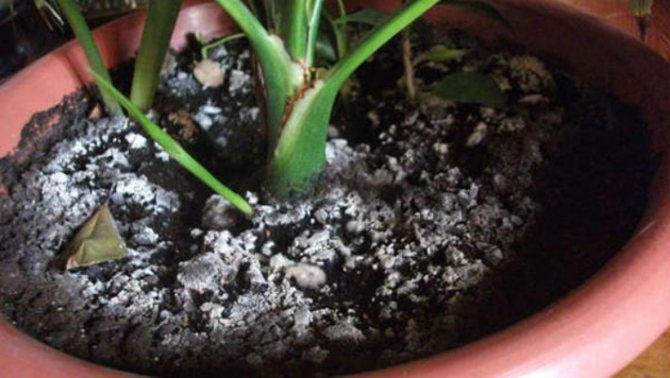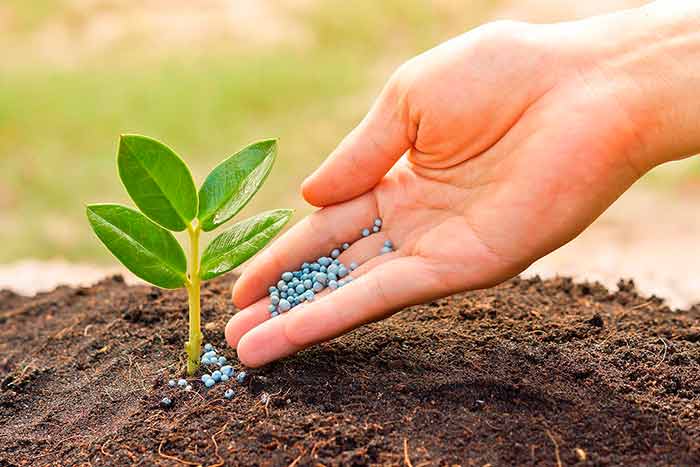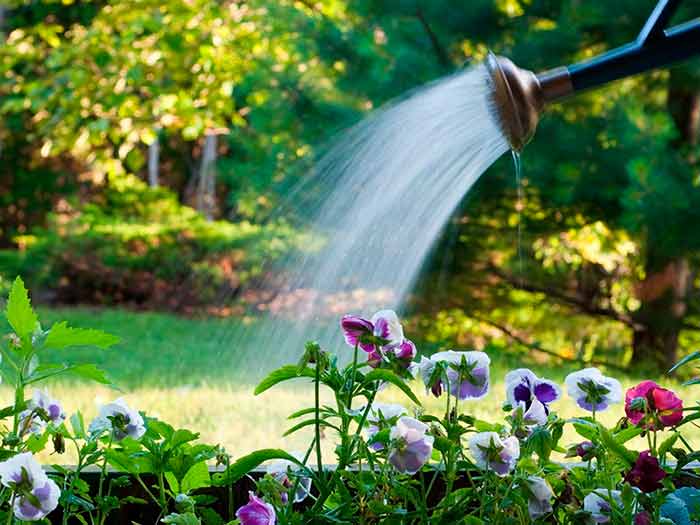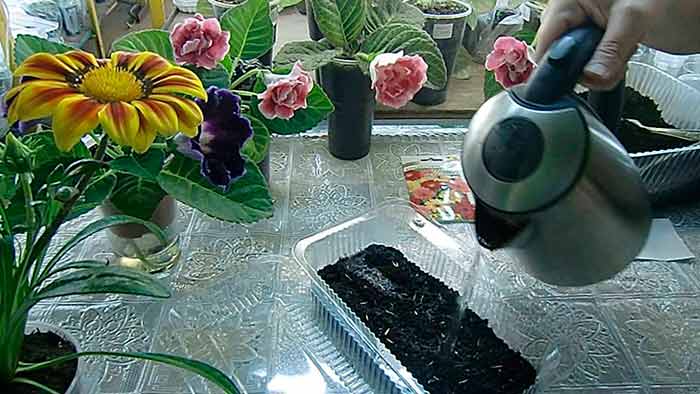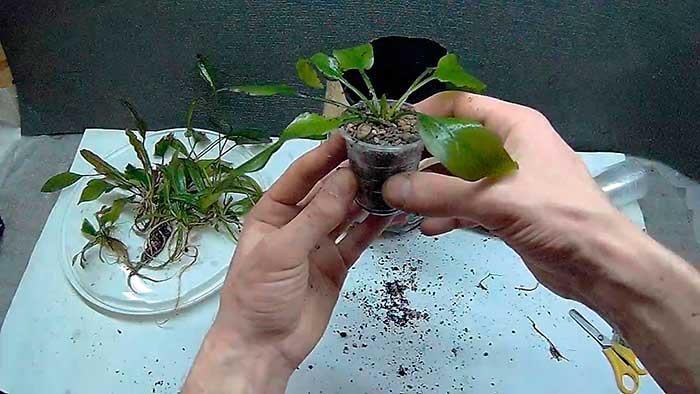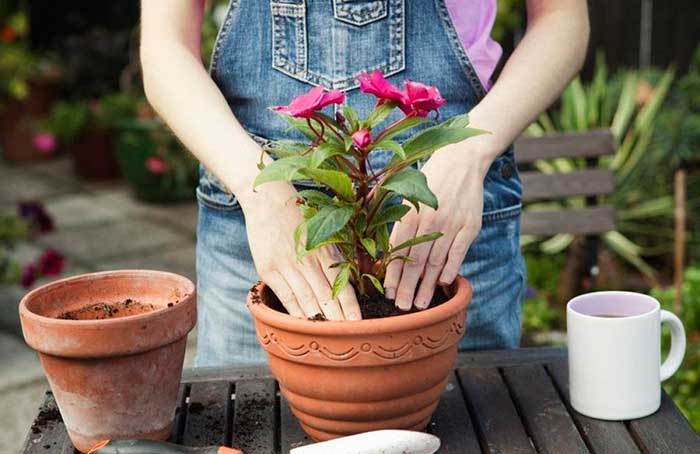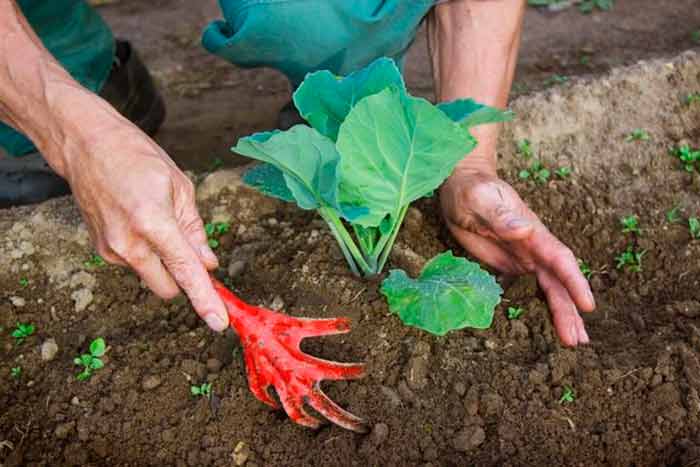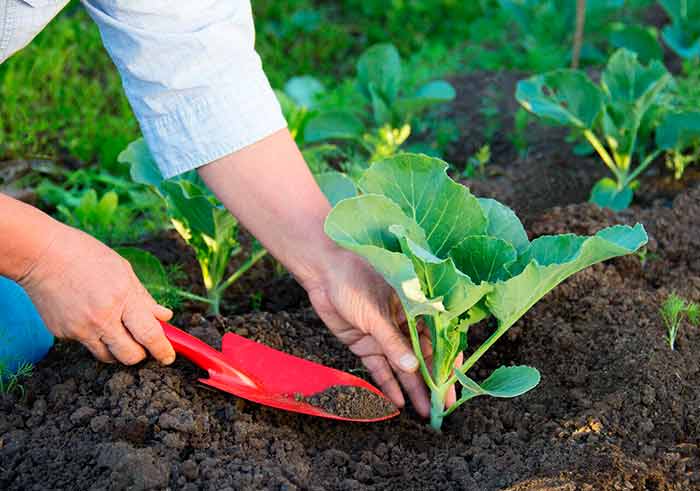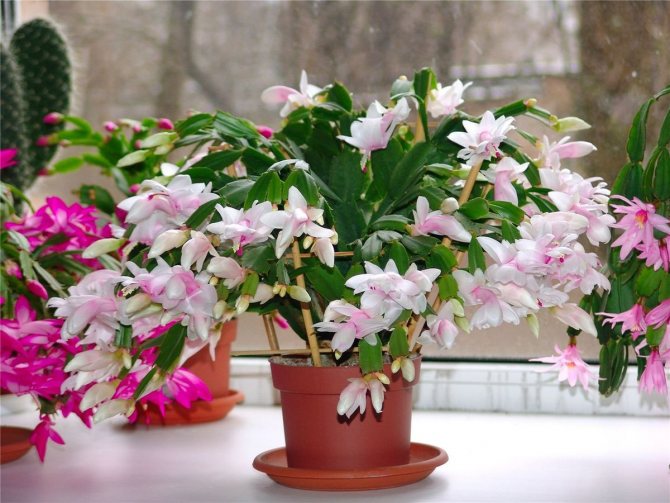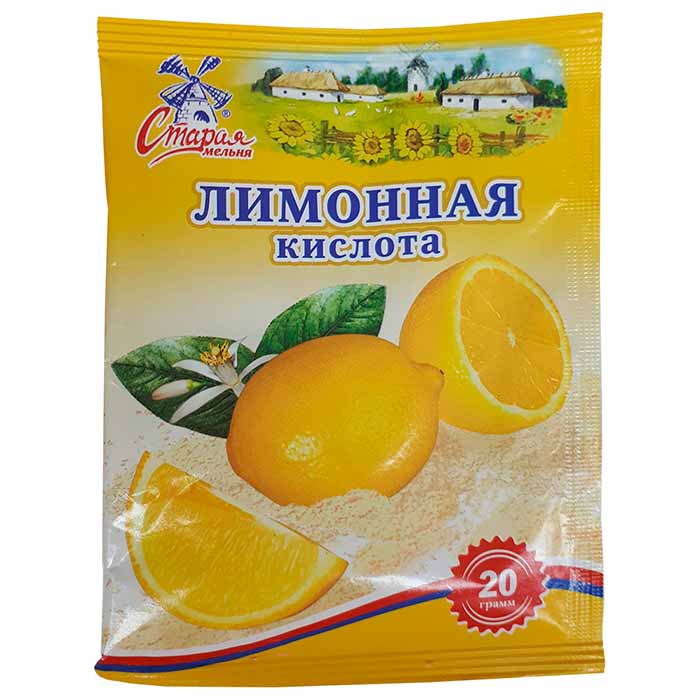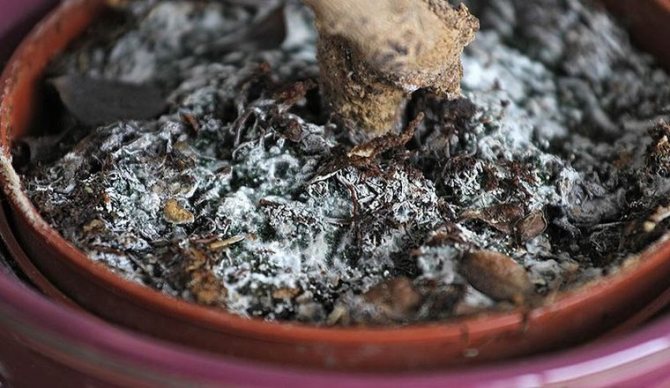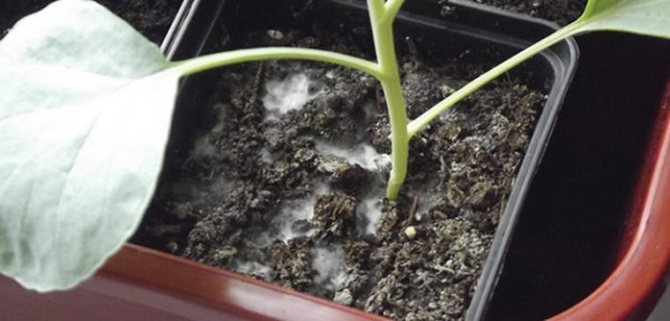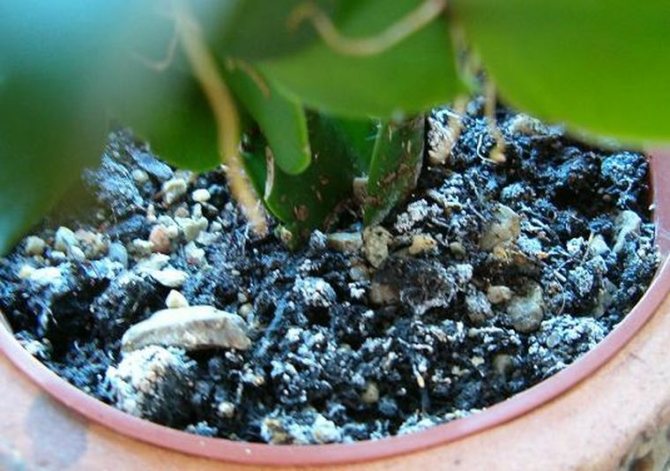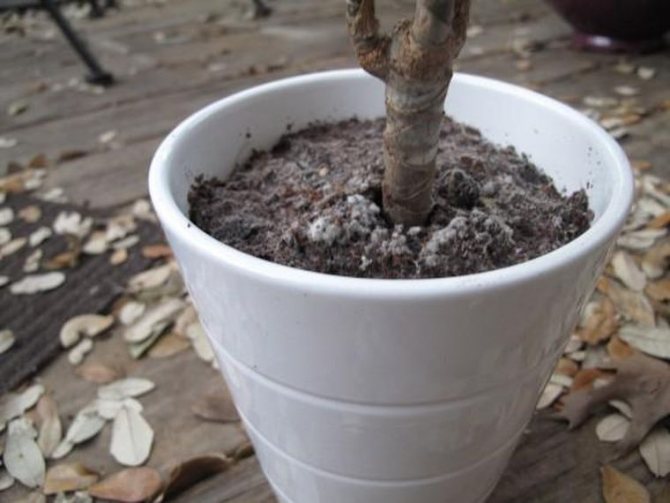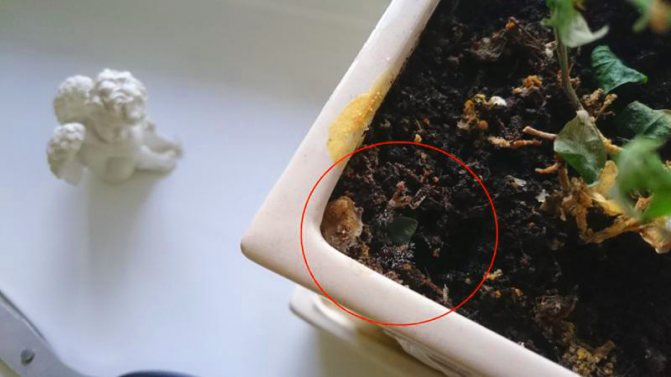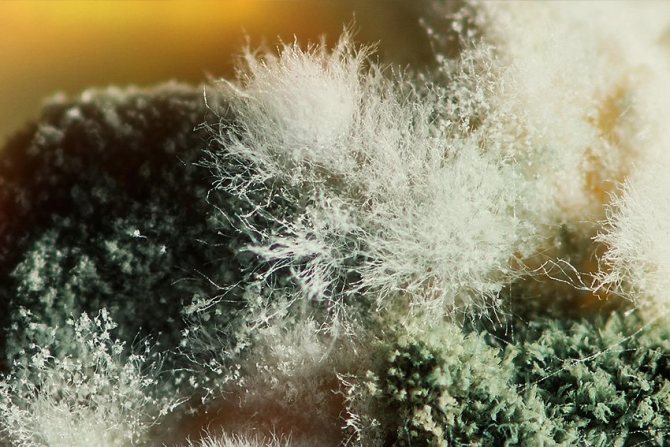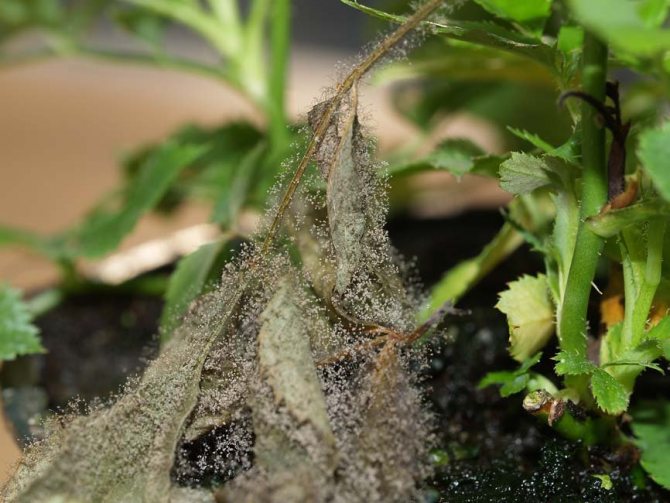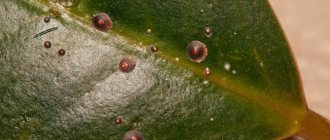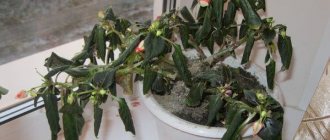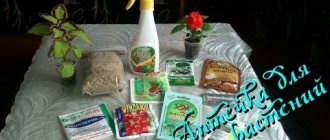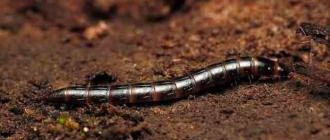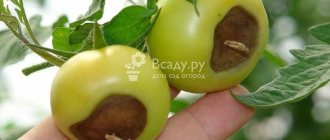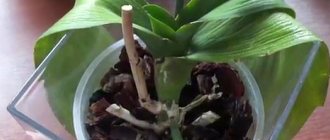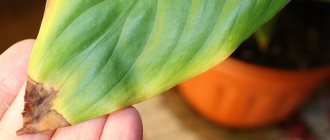Many growers, both beginners and already quite experienced, are faced with such a problem as mold in a flower pot. Moreover, it can appear not only in the soil, but also on the plant itself.
What are the reasons for the fungus and how to deal with it? Read on for more details.
Ways to get rid of white plaque
First, you must reduce watering. It is necessary to let the top layer of the soil dry out a little. The plant should be rearranged in a brighter place, regularly ventilate the room
There is less white and any other plaque if you cover the soil in a pot with expanded clay on top. Then, on the expanded clay itself, a white dried sediment appears, from time to time collect it and wash it, then into place.
It is recommended to sprinkle the soil with river sand and loosen the topsoil (along with sand). Loosening the soil with the addition of sand is very beneficial for plant roots. You can remove the top layer and add high-quality leaf or humus soil.
You can just remove all the white layer of the earth and add a new one
The stores sell a soil deoxidizer. The top layer of the earth with a bloom is removed and a little deeper and a deoxidizer is poured. It is good to water the flowers with aquarium water.
Water filters are recommended for hard water. To soften the water, you can lower a cloth bag with peat in a jar of water. For good, it would be necessary to pass water through the peat layer, then the salts are absorbed.
If it is still mold, drying out the soil gives a temporary suspension of the process, but the next time it starts to water, it starts with a vengeance. Collect it and sprinkle the soil in the pot with activated crushed charcoal, this prevents rotting and mold growth.
In addition to coal, periodically loosen the top layer, add another, healthy earth. Well, in the future, it is better to transplant the plant into a normal substrate, wash the pot with a stiff brush and laundry soap. From serious measures, you can shed soil with foundation, homom or oxychom.
voprosy-
How to cure a plant from powdery mildew?
Several recommendations before treatment:
- Water the flowers only after the topsoil is completely dry.
- Do not spray the plant while removing the powdery mildew.
- Place the flower pots in a brighter, sunnier place and let them sit there until they are completely cured of the disease.
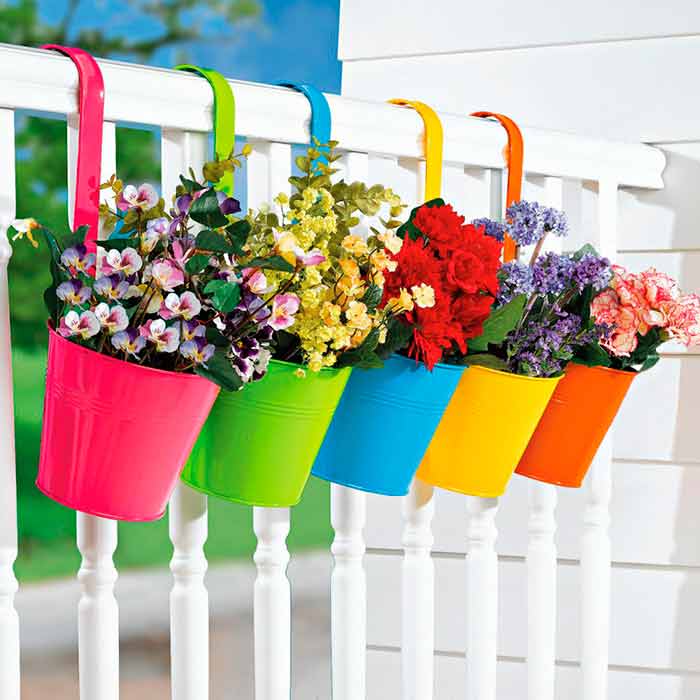
- Thin thickened plantings, tear off old leaves (especially those that are close to the ground).
- During the period of remission, use less nitrogen fertilizers and more phosphorus-potassium.
Attention! Discard any fertilizers while the flower is sick!
Mistakes in plant care must be corrected, otherwise white bloom on indoor plants will appear over and over again.
Now let's move on to the treatment itself.
To get rid of the disease, do the following:
- Tear off yellow, affected leaves.
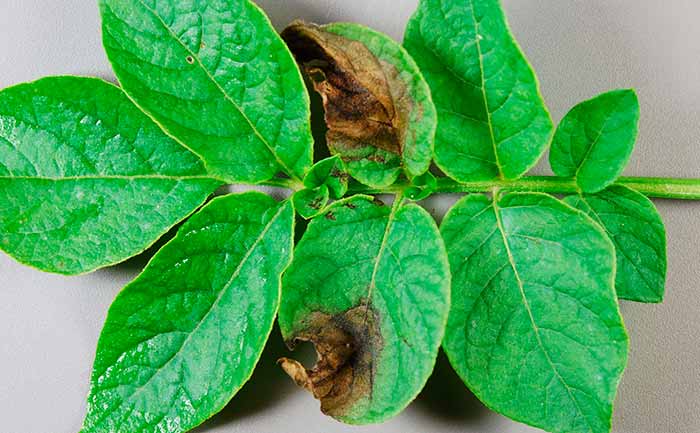

- If a white bloom appears on the leaves of a rose and other artisanal plants, it is advisable to cut off all infected branches - this will increase the chance of a cure.
- Replace the top layer of soil in a pot, container or under flowers in a flower bed - it contains "mushroom" colonies or mycelium (mycelium).
- Spray and water the plant with the medicinal product. During the procedures, make sure that the leaves and shoots are properly moistened.
- You can use another method: pour the medicine into a basin of water and place a bush there.
- The soil and pots / containers also need to be medicated.
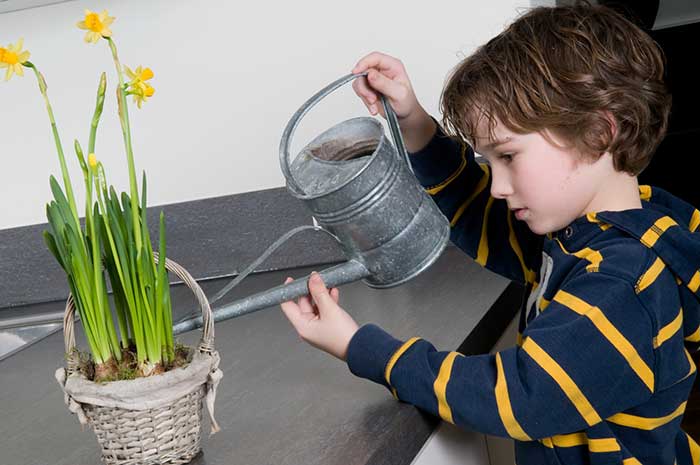

Why is the soil in pots covered with a white coating?
I think many people understand that most of these problems in the same home floriculture usually reflect our mistakes in caring for plants. A similar "white shroud" is an ordinary salt crust. It can be white, and sometimes white and yellowish. In such a crust arises in pots simply - when the physical evaporation of water from the soil significantly prevails over the evaporation of the same water of the plant itself. Again, there are several reasons for this, as always:
Perhaps the texture of the mixture in the flower pot is too heavy. That is why there is a high (sometimes even excessive) its capillarity and because of such capillarity, water is more intensively pulled up to the soil surface.
- Again, errors are not excluded when watering the plant. Perhaps you water immediately with water that you just poured directly from your tap. You do not need to do this, let it at least settle down a little.
- Drainage at the bottom of the pot can be difficult. If so, then again evaporation from the very surface of the soil in the pot will be the main way of spending moisture.
- Perhaps you have simply over-fertilized the mixture or you have already purchased such a mixture. Indeed, many manufacturers of such soil mixtures are guilty of this, especially if they make this mixture for vegetables.
- We "went too far" with top dressing.
- And a simple reason that immediately occurs to many is the banal dryness of the air itself. It is because of the dryness that evaporation increases many times over and the salts are thus “drawn out” to the surface.
In addition to all these points, white plaque can easily appear due to fungal microflora. This microflora is again created by our diligence, which we excessively show when watering. Therefore, to get rid of such plaque, water your flowers correctly. That is, when the top layer of earth in the pot is already dry.
What to do and how to get rid of it?
In order for such a white (and any other) plaque to be less, you just need to cover the soil from above with expanded clay. Of course, such a raid may appear on expanded clay after some time. Then they just remove it, wash it well and put it back in place.
- Another option is to sprinkle the soil in the pot with river sand. After that, the top layer, together with the sand, should be loosened. The very addition of sand and the subsequent loosening of the soil is very beneficial for the roots of your plant. Also, you can remove the top layer itself and simply add good leafy earth or no less good humus in its place.
- The easiest way is to remove all this "whiteness" along with the earth, and then add new ones there.
- If the water in your home is hard (and it is for the most part), then you should use filters. You can also water for irrigation and soften. To do this, simply put a rag bag in the jar, where you need to put a little peat.
One of the options for the appearance of such a raid is dry air, which is not uncommon in our apartments in winter. Because of this, we begin to water the plants more often, and for this reason the soil is covered with such a bloom. (How is everything interconnected !?)
P.S. Was the article helpful to you? Please share it with your friends on social networks. I would be very grateful to you.
What to do if a white bloom appears on the leaves of the plant?
Powdery mildew (ash, linen) - a rapidly spreading fungal disease.
The first "symptom" is a white bloom on the leaves, which at first glance may seem like ordinary dust.When the leaves are covered with it, the plant loses nutrients, and the process of photosynthesis stops.
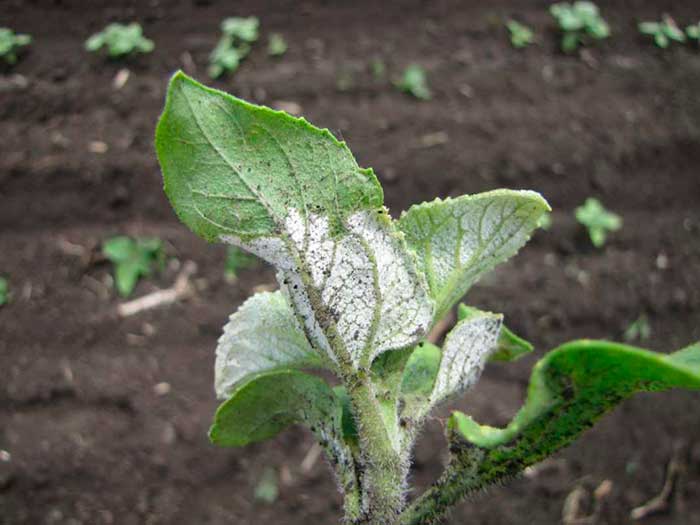

At first, white bloom appears only on the lower leaves of violets and other plants, but over time the disease progresses, moving to the rest of the plant. The leaves turn yellow, wither, and the new leaves have an unhealthy appearance, grow twisted.
If you do not take up the treatment of the plant in time, it will soon die.
I recommend reading - White mold in orchids.
What are the reasons for the disease?
Fungal spores are always found in the soil, but with proper plant care, they are not “activated”. The fungus begins to manifest its evil essence if:
It's damp, cold outside
For example, it rains every day. In this case, white bloom on the leaves of ficus and other plants often appears when they are grown on the street or balcony.
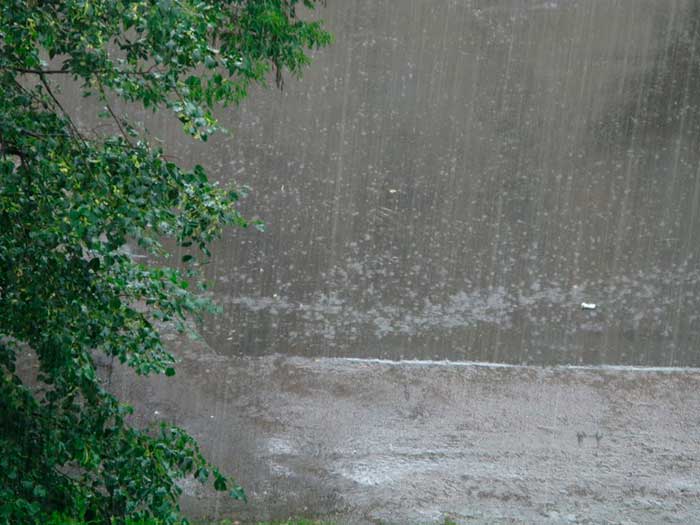

Irrigation regime is not observed
For example, white bloom on the leaves of begonia and other flowers appears if the plant is watered too often, when the top layer of the earth has not yet dried.
Or, on the contrary, the soil is overdried, and then it is poured abundantly.
Spores can get on the plant in other ways:
- by air (for example, if the wind blew and air currents brought spores from other plants and trees);
- with water (for example, if the water for irrigation was settled in a bucket in an open place, and spores landed in it);
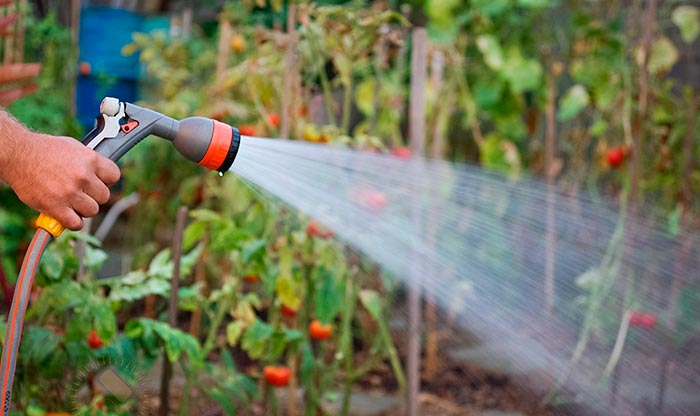

- through hands (for example, if you touched another infected plant before working with a healthy plant).
Waterlogging of the soil
White bloom on the soil of indoor plants is formed for various reasons.
- Improper watering is one of the main ones. Water, which is supplied to the plant in excess, begins to actively evaporate, forming salt on the surface of the soil.
- Their accumulation also occurs in the case of poor watering. In this case, only the upper layer of the substrate is impregnated with water. I water the plants so that the water passes through the entire soil, but does not stay in it. For this I create a good drainage layer. It allows excess water to leave after irrigation and not evaporate on the soil surface.
- Dry room air also leads to intense evaporation of water, and salts are quickly carried to the topsoil. It gradually becomes salty, and this plant starts to hurt. I now constantly monitor the humidity of the air and noticed that the salt crust has ceased to form.
Danger to plants
Why it is necessary to get rid of mold and its spread should not be allowed:
- The plant begins to ache as mold prevents nutrients from entering the stems, leaves and flowers.
- The root system is not getting enough oxygen.
- A fungus in the soil can provoke various diseases of the flower.
- Due to the increased humidity, the roots of the plant can begin to rot.
If you do not fight the moldy fungus, the plant will rot and die.
Fertilizer oversaturation
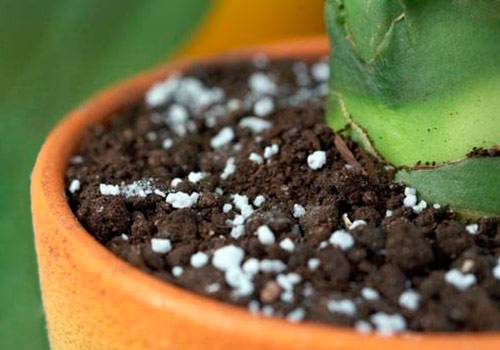

White bloom on the soil forms if the houseplant is overfed with fertilizers. Once I bought a substrate in the store and over time I discovered that the soil in the pot began to be covered with a white coating. It turned out that I had acquired soil intended for planting vegetables. Manufacturers usually oversaturate such mixtures with fertilizers.
Improper plant nutrition can also disturb the condition of the soil. During the growth period, it is important to accurately calculate the dosage. During dormancy, I do not fertilize the houseplants at all.
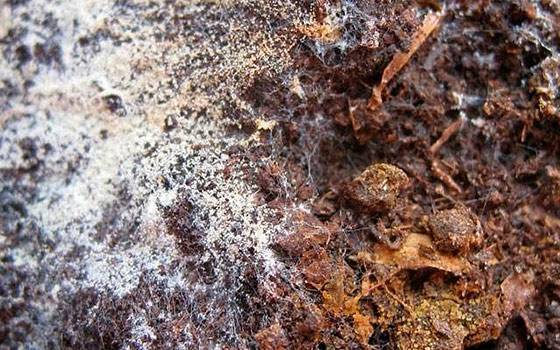

Plaque can also be caused by too much soil that does not match the size of the plant and its needs. The roots will not fully absorb moisture, and its excess will begin to form salt deposits when it comes to the surface. Therefore, I always select a pot according to the size of each particular plant.The soil in the pot is also covered with a white bloom from too soft water.
Prevention of the appearance of a fungus
Preventing all types of mold in a flower pot is easy. Regular care of the flower, adherence to temperature indicators and watering norms will bear fruit.
Six simple rules will reduce your risk of developing molds:
- moderate watering with lukewarm water;
- arrangement of drainage at the bottom of the flowerpot;
- indoor temperature optimal for plant development;
- mixing soil in a pot with pieces of charcoal. A good option is crushed activated carbon for soil disinfection;
- watering for the prevention of rot with a solution of citric acid;
- regular loosening of the soil.
What to do if mold gets in the pots of houseplants? How to deal with colonies of fungal formations? Useful tips for flower growers in the following video:
White mold that appears on the ground in flower pots occurs due to improper care or the influence of negative external factors. Plaque usually begins to spread where the soil and the pot meet. It can be white or brown in color and has a high spreading rate.
There are many disputes in the air all the time. Under favorable environmental conditions, colonies of fungi are formed from them, which begin to multiply rapidly.
Biological processes
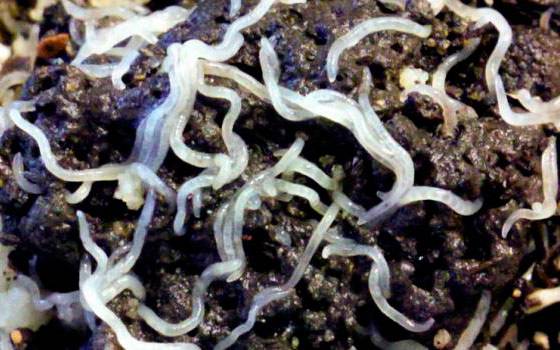

In addition to physical processes that affect the formation of white plaque, biological factors also affect the soil surface. One of them is fungal microflora. It is formed, again, from over-watering.
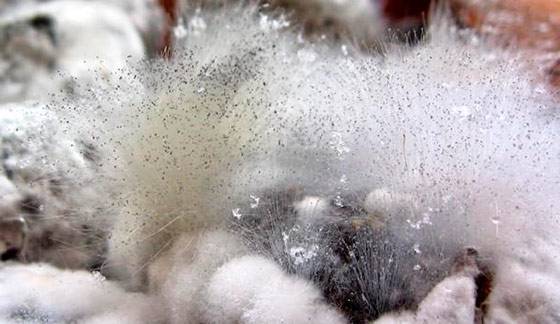

It happens that the acquired land already contains mold. For adult indoor flowers, this is not as dangerous as for young seedlings. Sometimes this mold grows all over the depth of the pot. I get rid of such a substrate as quickly as possible. And do not throw it into the garden! Somewhere away under the fence.
sait-pro-
Causes of the appearance and spread of the fungus
There may be several reasons why a fungus forms on the surface of the soil:
- Using the wrong regime of watering the plant, which leads to stagnation of liquid and an increase in soil moisture.
- Low temperature and high humidity of the room in which the flower is located.
- Application for cold water irrigation.
- Poorly functioning drainage system. If the holes do not match the size of the pot, then they are clogged. Which leads to stagnation of water in the soil. After 2-4 days, the first traces of mold may appear.
- Poor quality soil.
Problems with the soil in the flower pot
If the soil in the flower pot or in the garden has been flooded, then emergency measures must be taken to save the flower. How to save a flooded flower in the country? The first step is to remove the flower from the pot and leave it to dry for several hours. It is advisable to plant the flower in new soil, but if necessary, you can save the old soil by reusing it. To do this, it must be treated with antibacterial solutions and steamed in a microwave oven for 15 minutes. After that, the soil is well dried and used for planting.
If the soil in the flower pot has not yet become covered with green mold, then the symptoms of waterlogging are eliminated quite easily. A little clay, sand or wood ash is poured on top of the soil, which will absorb excess moisture. You can also loosen the soil with a wooden stick and make deep punctures in it, which eliminate excess moisture. The easiest way to dry the soil is to line the potted soil with regular paper towels. It is very important to check the drainage holes of the planting tank if problems arise with the soil. After all, they can be clogged, which is why the soil in the flower pot is constantly wet and does not dry out. You can find out how to make a planter for flowers with your own hands here.
Plaque on the surface
If the soil in the flower pot receives an excess of water, then a white or yellow bloom appears on the surface of the soil. The main reason for this is watering with very hard water. Because of this, a calcareous sediment forms on the surface of the soil, and it turns white. This problem is resolved in several ways. The first thing to start with is to exclude watering flowers with water directly from the tap. It should stand for one day. You can also add citric acid to the water. For one liter of water, half a teaspoon of the substance, thanks to this, it is possible to neutralize lime compounds.
In addition, to prevent the formation of white bloom, the soil is covered with expanded clay, which absorbs excess moisture. And you can also sprinkle the soil in the pot with coarse river sand, which is loosened along with the earth. Such activities have a beneficial effect on the health of the flower roots. The next way to remove excess moisture is to remove the top layer of soil and add dry, leafy soil to the pot. The surest and easiest way to remove plaque on the ground is to install a water filter in your home that will soften hard water. To soften the water, cloth bags with peat are dipped into it.
Mold in pots
When the soil in the flowerpot is very wet, it becomes a breeding ground for mold, so the plant needs to be properly watered and well drained to prevent water from stagnating. If the soil is already moldy and black soil bugs have started up, then watering is immediately stopped, and the root system of the plant is dried. The outer layer of soil must be removed at a height of at least 2 cm and replaced with fresh substrate.
If these measures did not give a positive result and the soil in the flower pot remained moist, then all the soil will have to be replaced. Before planting, the flower, together with an earthen lump, is removed from the pot and left to dry for at least one day. The old earth must be thrown away, and the new one must be steamed at a high temperature. If a ceramic pot is used for planting, then it should be doused with boiling water. The ceramic pot needs to be boiled in water for a few minutes.
When the soil becomes moldy in a plastic pot, it is better to throw it out, since there are spores of fungi on its walls, which will multiply in the new soil. At the bottom of the pot there should be a layer of expanded clay drainage. The top layer of soil is sprinkled with sand, which will help to avoid high humidity.
Midges in the ground
Sometimes the soil in the flower pot is covered with small midges that feed on rot. The first thing to start the fight with midges in orchids is to remove all wilted and poorly decaying parts of the flower, which feed on harmful microorganisms and insects. It is very difficult to deal with them, so it is easier to get rid of the old soil, rinse the roots of the flower and plant it in a new, steamed substrate. It is also necessary to process the roots before transplanting.
Waterlogged soil in a flower pot readily attracts small pests that lay their eggs on the ground. To prevent such a nuisance, the top layer of the flower's soil must always be dry, and sufficient drainage holes must be provided in the pot. To prevent the reproduction of midges, the room in the house must be regularly ventilated and treated with special preparations against insects.
It is advisable to hang flycatchers next to houseplants, since these insects are carriers of all kinds of plant diseases. Alternatively, folk remedies can be used to combat midges. For example, take 20 grams of laundry soap and grate it. Then dissolve it in a liter of water and spray the flowers with this composition once a week. The soil in the pot is also watered with a weak solution of potassium permanganate, which also gives a good effect.
Bad smell from soil in a flower pot
To prevent the earth from smelling, it is necessary to remove the upper part of the soil.The remaining soil is treated with a disinfectant solution from basezol or water with manganese. The missing part of the soil is replaced with fresh soil, which is steamed in advance in a microwave oven for 15 minutes. Then it is dried well and placed in a flower pot. It is also important to keep an eye on drainage holes that may be clogged.
Effective control methods
When detecting a strange plaque in a flower pot, it is important to understand what conditions led to the development of molds. Only after elimination of the provoking factors will the risk of soil mold growth be minimal.
Ten rules for successfully fighting mold in a flowerpot:
- check the temperature and humidity in the room. Install a lamp closer to the plants, if it is cold at home, stop excessive watering when moisture accumulates;
- remove the top layer of earth 2-3 cm thick: the penetration of harmful fungi into the deep layers of the soil should not be allowed;
- replace the removed soil with a nutrient-enriched bactericidal substrate. Peat, charcoal, sphagnum moss, special mixtures from a flower shop are suitable. Many gardeners recommend adding a couple of crushed activated carbon tablets to the soil. The sales assistant will tell you the best option for each plant;
- prevent further development of the fungus. Experienced flower growers recommend Fundazol solution (for 1 liter of water - 2 g of the drug). Watering according to the instructions for the antifungal agent;
- carry out preventive watering. A solution of the available components will help prevent the appearance of mold on the soil: ½ tsp is enough for 250 ml of water. citric acid. Water the indoor flower with the product twice a month. A simple operation will slow down the spread of the fungus that lives in the soil;
- treat the soil with a special antifungal compound, if root rot ("black leg") has started in the soil. The danger of this type of mold is the late detection of a fungal disease. Florists learn about a serious disease of a plant only by rotting leaves and stems. If root rot is detected, chemicals will be needed: citric acid is powerless here. At an early stage, a solution of potassium permanganate helps well, with a severe degree of fungal infection, the affected plant is sprayed with a Bordeaux mixture, cuproxate or colloidal sulfur;
- to loosen the soil. This operation prevents moisture stagnation, improves oxygen access to the roots, and normalizes gas exchange between the soil and roots. Dense, "heavy" soil is the fastest way to salinity, the development of pathogenic microorganisms;
- transplant the plant. With a large accumulation of mold on the surface and in the ground, severe infection of the flower, transplanting into a new flowerpot, a complete replacement of the earth is the only way out with which you can save your pet. Gently remove lumps of soil, rinse the roots with a fungicide solution. In a new pot, equip the correct drainage system (cover the holes at the bottom with pebbles of a suitable size), pour high quality soil, plant a plant, sprinkle with peat or charcoal on top;
- disinfect the soil. If for some reason it is impossible to purchase new soil, you can decontaminate the soil. The method is simple but effective. Gently collect the earth from the roots, remove from the flowerpot, fold into a wide container, pour over with boiling water. The next step is to fry the soil in the oven. Pour boiling water over the pot or place it in the oven for disinfection (if the material allows). Before replanting the plant, the roots must be thoroughly washed from the remnants of the earth, rinsed with Fundazole solution;
- take care of the indoor plant more carefully. Poor care, rare loosening, stagnant moisture with excessive watering often provoke the appearance of mold. Flower shops offer helpful books on indoor flower care.A lot of relevant, interesting information for beginners and experienced florists is easy to find on the Internet.
How to get rid of ants in an apartment forever? Find out effective methods and rules for dealing with parasites.
Look at this page for an overview and rules for using lice and nits shampoos for children.
Why do animals eat and dig the ground?
Usually young Alabai puppies and kittens, who are just mastering the new world and trying to taste everything, dig or eat earth, grass, coal. How to wean a puppy or a child if he climbs and rakes the soil? The animals are driven by the usual curiosity, so after several attempts to eat the earth, everything stops. A toy terrier puppy will understand that the earth is not tasty and will not try it again. However, this symptom is not curiosity, but the reason for the psychological state of the dog or cat. This happens due to the fact that the animal does not feel comfortable in the house or has dislike for a new family member.
Perhaps the owner treats the cat or dog badly, punishes him, and he takes revenge in this way. Sometimes animals gnaw and tear off furniture, walls or shoes of their owner. Therefore, in order to understand why an animal licks clay and sand, digs or eats soil from a flower pot, it is necessary to examine its health, for example, for cat anemia. If the reasons lie in the personal enmity of the animal or in psychological discomfort, then the owner and his household should give the pet more affection. It is very important to communicate more with the pet, give it time, praise it, play with the animal.
Mold control methods
If mold appears in the ground and smells like rot, then it is necessary to adjust the watering schedule of the plant. It is recommended to reduce the frequency of watering and reduce the volume of liquid... For some plants, it is sufficient to have a moist soil. Otherwise, the roots can start to rot, leading to fungal infections.
With abundant, but rare watering, it is necessary to systematically loosen the soil. Moreover, the deep layers should be affected. But you should be careful, as you can damage the root system.
How to get rid of mold in flower pots without harming the plant:
- If a fungus is found, it is necessary to remove the outer layer of soil from the flower pot... If this is not done, then the infectious fungus will begin to spread to the inner layers, which will lead to rotting and death of the flower.
- Next, you need to moisten the lower layers of the soil.... To do this, a glass of water with citric acid diluted in it is poured into the pot. The acidic environment prevents the fungus from multiplying, which favorably affects the growth of the flower.
- Replace the removed layer with new primer... It is necessary to add bactericidal agents to it, which will also act as filtering components for the incoming moisture. It is recommended to use additives such as crushed sphagnum and charcoal pieces.
- Further, the earth is watered with a special composition of foundation: 2 grams of the product must be diluted in 1 liter of water. If the infection spreads to the plant itself, it should also be treated with a solution.
In order for the soil cultivation to have an effective result, it is periodically required to loosen its top layer. This will distribute moisture evenly and prevent stagnation.
If the soil in the pot is covered with white mold, then it is necessary to water the plant with a solution of water with citric acid at a frequency of at least 2 times a month. For 1 glass of liquid, 0.5 teaspoon of acid is taken.
Video: Mold in a flower pot, how to get rid of white plaque on the ground.
Plant transplant
If mold appears in a flower pot, how to get rid of it quickly and effectively? An effective way to eliminate fungal infection is to transplant the plant into a new pot with a complete replacement of the soil. The soil should be selected taking into account all the rules for planting.For certain plants, it is necessary to find out the optimum moisture in advance.
Soil disinfection
To get rid of infection and mold odor, you can disinfect the soil according to the instructions:
- Separate the infected soil from the plant roots.
- Remove the soil from the flower pot and transfer it to another container.
- Put water to boil.
- Pour boiling water over the soil.
- Place the soil on a baking sheet and heat in the oven.
- Wait for the substrate to cool down.
- Treat the pot with a special disinfectant. You can also fire the pots with an open fire.
- Return the soil to the pot and plant the flower.
Purchased funds
You can get rid of mold with chemicals. These can be purchased at flower shops.
But when choosing this method, you should consider:
- type of soil;
- plant features;
- the degree of spread of the fungus;
- what fertilizers were used to cultivate the soil.
By using the wrong product, you can get the opposite effect.... And sometimes it is impossible to use chemical reagents to eliminate mold stains.
The advantage should be given to organic preparations that affect the soil and make it unfavorable for the development of the fungus.
Signs about a flower pot in a dream
When you dream of flowers in pots, this is one of the most favorable stories that predicts good luck and success in the future. Perhaps there is a large material reward in front of a person, or he will buy expensive property. However, this interpretation is true in the case when the flower did not fall and dreamed of blooming, green and fresh. If in a dream a person sees sluggish, dried flowers, then this may indicate trouble in the future. For example, there will be troubles at work, financial losses or family quarrels. When a flower falls off in a dream, it speaks of illness.
If in a dream a person dropped and broke an empty pot on the floor in the room, poured earth from the pot or broke it, then this may portend a family discord in the future, up to a divorce. Also, scattered earth at night speaks of illness, loss of loved ones or financial difficulties. It is worth considering that dream prediction may depend on who dreamed of the flower pot. For example, if a young girl dreamed of a beautiful flower, then a wedding awaits her. For older women, a blooming flower speaks of a possible pregnancy, and for older women, such a dream promises the presence of diseases of the reproductive system.
Tips to Prevent Fungus Infestation
If you regularly take preventive measures, then you can avoid problems such as mold and the smell of rot. The process of getting rid of the fungus is much more difficult and takes longer. When creating favorable conditions for plant growth and acquiring high-quality soil, the probability of contamination of the land with a fungus is minimal. therefore it is necessary to provide systematic ventilation, sufficient lighting and an optimal level of humidity.
Indoor plants should not be in a draft. Special shelves or flower stands are best suited.
If there are indoor plants in the house, it is not advisable to use a humidifier. Since at a high level of humidity, favorable conditions are created for the development of infection.
In order not to think about the question of how to remove mold from the ground, some tips to follow:
- buy soil at specialized retail outlets;
- before purchasing, you must read the composition of the soil;
- if the substrate is too heavy, then it is not recommended to purchase it, the fungus will spread in it even faster;
- before planting a plant, it is advisable to treat the soil with potassium permanganate, it will disinfect it and reduce the likelihood of the appearance of a fungus.
Before breeding certain types of plants, it is necessary to familiarize yourself with the features of their growth and adhere to the recommendations for watering them.
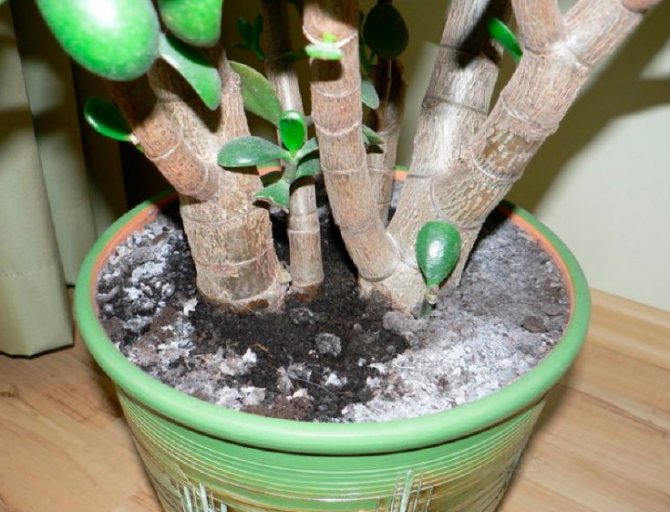

Quite often, white mold appears on the ground in flower pots, although its color can be different. As a rule, it appears either under the influence of external factors, or due to improper care of indoor plants. A white bloom appears first at the border of contact between the soil and the pot, and then quickly fills the entire space.
This may be due to the fact that there are spores of fungi in the air, which, under certain conditions, begin to multiply rapidly, growing into whole colonies. This is dangerous not only for the plants themselves, but also for the people living in the apartment.
Potted soil decoration
When decorating the ground in a flower pot, in most cases fine gravel is used, which is painted with multi-colored dyes.
Painted stones are washed with water and poured into a lump in a flower pot with a layer of up to 2 cm. If desired, patterns, drawings or ornaments are made of colored stones. The main thing is to show imagination and use stones of different sizes for mulching, ranging from 2-3 mm and ending with large specimens up to 1 cm.
Fine orange gravel or coarse colored sand, which can be purchased at a flower shop, is also used to decorate the topsoil.
Usually soil is decorated for different sized cacti in landscaping. Group plantings of succulents of different varieties, which are decorated with multi-colored pebbles, look very impressive. You can also use sea, small pebbles, pebbles for decoration. For plants that need high humidity, sphagnum moss is used, which makes the surface of the soil a rich green color. If the moss has lost its useful properties, then its top layer turns brown. In this case, it is replaced with new moss. A lot of useful information in the article: Do-it-yourself garden and indoor flower stand from various materials.
What types of mold appear on the ground?
Mold in a flower pot can be different, but mainly on the surface of the earth, the following two types are found:
- Mukor (Latin Mucor) or white mold. Mushrooms in a flower pot are quite common, especially when it comes to the Mucor variety. This type of mold forms in the upper layers of the soil and looks like a white fluff that is easily rubbed in the hands.
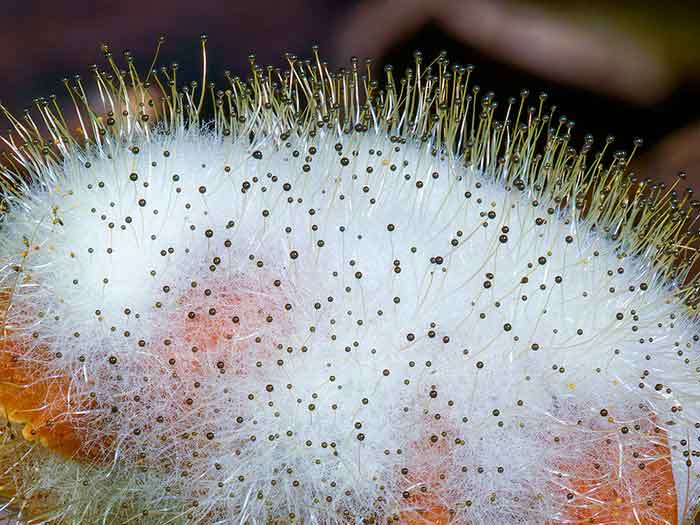

- Efflorescence (efflorescence) or white bloom of soluble salts. Despite the fact that this species does not at all look like mold that is familiar to the eye, the harm from it can be no less. Salt or alkaline plaque, in contrast to the white mold in the form of a gun (Mukor), affects the soil surface, as well as internal areas. Efflorescence (efflorescence) looks like a crystalline coating of white or gray (but sometimes it can have a greenish tint).
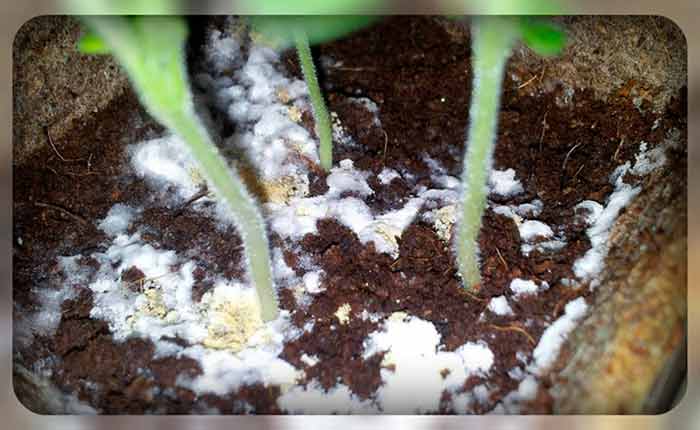

Another fairly common ailment of indoor plants is “root rot " or, as it is also called, “blackleg"... She lives in the soil and does not show herself on the surface, like Mukor or Vysols. Despite this, its presence can still be determined. The leaves of plants affected by root rot curl, turn black, and rot.


It is advisable to get rid of root rot as soon as possible, because in this case there will be much more chances to save your favorite flowers.
I recommend reading - Mold on seedlings.
Mold - what is it
This is a microscopic fungus, consisting of branching filaments - hyphae. Most often, these fungi reproduce by spores. There are many of them in the air around us, they are in the soil and on various objects. Mold feeds on organic debris. The best conditions for its development are warm and high air humidity.
Mold is surprisingly tenacious. She was found in space and on the walls of a nuclear reactor at Chernobyl.She is not afraid of frost, so freezing the soil does not rid it of fungal spores. It is extremely difficult to fight mold fungi, it is best simply not to create optimal conditions for their existence and development.
Reasons for the appearance
A harmful plaque appears in a flower pot, regardless of the type and age of the plant. Spores of pathogenic fungi are often in the air or in a pot with contaminated soil.
Most often, the appearance of a dangerous fungus on the soil is provoked by flower growers. Improper plant care, inappropriate temperature conditions, excessive moisture stimulate the growth of fungal microflora.
Often, indoor plant lovers believe that moldy soil is observed only where flowers require abundant watering. This opinion is erroneous. Unfortunately, harmful white bloom often infects the soil in flowerpots with cacti, ficuses and violets.
Provoking factors:
- waterlogging of the soil with excessive watering;
- high air humidity;
- poor soil quality;
- watering the plant with cold water;
- the house is too cold for a certain type of indoor flower;
- fence of low-quality soil from the nearest flower garden, and not buying in a specialized store;
- stagnation of moisture due to improper arrangement of the drainage system.
Why is she dangerous
Penetrating into the respiratory tract of a person, it settles in the lungs. Mold accumulates in the body and causes various diseases, including allergies and toxic poisoning. Mold is especially dangerous for people with low immunity.
It negatively affects plants:
- mold is a fungus, followed by more aggressive fungal races, from which the roots of seedlings can rot, possibly a black leg disease;
- plant nutrition is disrupted, mold waste products have an acidic reaction, therefore, they change the acid-base balance of the soil for the worse for plants;
- oxygen is poorly supplied to them;
- their immunity decreases and tissue regeneration worsens.
Most of all, mold is dangerous for small seedlings that have not yet been dived. The adult seedlings have already mastered the entire volume of the pot, its root system secretes substances that suppress the growth of molds, and the gardener will have to take care of the "kids".
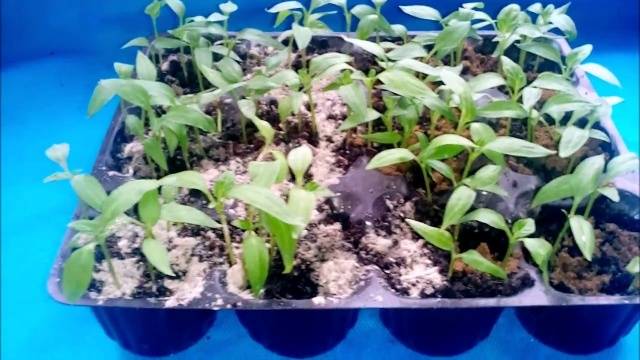

Seedling crops are grown indoors. It would seem that in a confined space nothing bad can happen to them, there is no contact with the street, and molds simply have nowhere to come from. Why does the soil become moldy in seedlings?
Mold control methods
When the first signs of mold growth appear, which may be accompanied by a specific odor, you need to pay attention to the watering schedule of the plants. It is possible that the irrigation schedule is not suitable for this type of plant and the volume of liquid must be reduced. Typically, many plants do not need frequent watering.
If a plant requires abundant watering, then it must be alternated with loosening the soil so that it can breathe, but this must be done very carefully so as not to harm the root system.
Methods for getting rid of mold in pots:
- If you notice the appearance of mold, then you need to remove the top ball of soil as early as possible, until the fungus begins to penetrate deep into the soil. If he gets to the root system, the plant will quickly die.
- After that, the lower layers of the soil are moistened with the addition of citric acid, which stops the growth of the fungus and has a beneficial effect on the growth of the flower.
- Then, instead of the removed upper ball of soil, a new ball is poured, with the addition of antibacterial drugs. As an additive, it is permissible to use small sphagnum and pieces of charcoal.
- In conclusion, the soil in the pot is watered with the addition of foundationol: 2 grams of this substance is dissolved in 1 liter of water. If the infection has managed to infect the plant itself, then it is treated with the same solution.
So that the soil does not stagnate and can breathe, it is necessary to regularly loosen the top layer. This leads to an even distribution of moisture throughout the pot.
If the soil in the pot begins to become covered with white mold, then the flower should be watered with a solution of water and citric acid at least 2 times a month. To prepare the solution, you need to take 1 glass of water and half a teaspoon of citric acid, then stir everything until the acid is completely dissolved.
Reasons for the appearance of mold in containers with seedlings
The source of fungal spores, from which mold develops, can be:
- the soil;
- mold that is already in the room;
- seeds - they can also contain fungal spores.
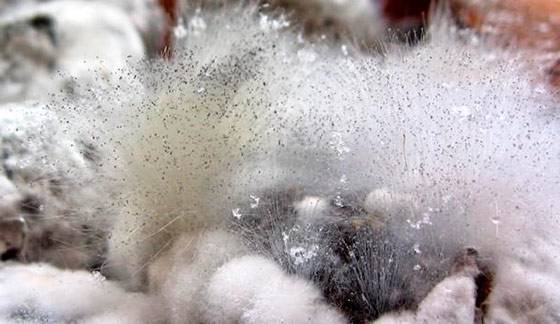

The following factors also contribute to its appearance:
- heavy soil structure in containers with seedlings;
- a large amount of undecomposed plant residues in the soil is the best food for molds;
- high acidity of the soil, if the soil is neutral, the growth of molds is suppressed by other microorganisms that are in the soil, but with increased acidity, these mold fighters die;
- the soil in the seedlings grows moldy with an excessive amount of organic matter in the soil;
- poor drainage or lack thereof, in this case, excess moisture is not removed through the holes, but evaporates from the soil surface, creating increased air humidity;
- too large a volume of planting capacity - the root system does not encircle the entire soil, it sours at the walls of the pot, which contributes to the development of mold;
- rare ventilation and stagnation of air in the room;
- irrigation with unsteady water with a high content of mineral salts;
- too frequent and plentiful irrigation of seedlings;
- absence of ultraviolet rays, window glass completely stops them.
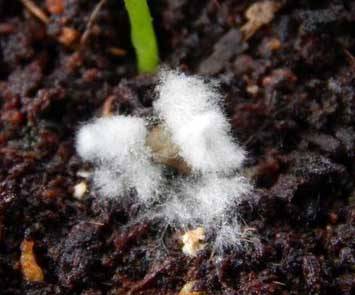

Mold is dangerous not only for seedlings. It so happens that it appears on the surface of the soil before the seeds have sprouted. In this case, shoots can not be expected. The fungus hyphae are capable of germinating into sown seeds. The embryo will die and there will be no shoots. Often, to accelerate seed germination, containers with crops are covered with foil. The microclimate underneath it is just perfect for the growth of molds. If there are spores there, they will certainly germinate, and the gardener will observe mold on the soil when growing seedlings.
The color of the mold depends on the type of fungus. In the landing containers, white fluffy bloom often appears. If white mold appears on the ground with seedlings, it is a mushroom from the genus Mucor. It usually lives in the surface layers of the soil. Mucor can also be observed on food, for example, on spoiled bread. Mucor food - biological residues, which are many in insufficiently decomposed soil.
If white mold appears on the seedlings, what should I do? The first step is to raise the temperature where the seedlings are growing. Mukor thrives best in cool conditions.
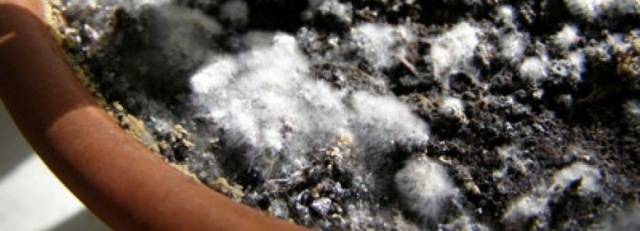

Mold in pots with seedlings can be of a different color: green or even black. The latter is especially dangerous for both humans and pets, who can also suffer from it. If brown mold appears on the seedling soil, measures should be taken immediately. How to deal with green mold in seedlings? In the same ways as with the rest of its types. The main thing is to do it quickly. Every day, the fungus hyphae grow and harm the plants more and more.
If the soil with seedlings is moldy, what to do in this case? How to deal with mold on seedlings?
Harm to plants
Mold on the surface and inside the soil not only spoils the appearance of the soil, but also provokes problems with the growth and development of indoor pets. Rotting roots negatively affects the condition of plants.
Inexperienced growers think that removing unaesthetic plaque will solve the problem.This is a misconception: only an integrated approach to removing mold, eliminating the conditions for the reappearance of the fungus will give a noticeable effect.
What is the danger of white plaque on the ground:
- the vital activity of the plant deteriorates;
- a dense layer on the soil allows less oxygen and nutrients to pass to the roots;
- the quality of the soil decreases markedly: the density of the soil increases, acidity and mineral composition are disturbed;
- mold fungi provoke various diseases, worsen the condition of the indoor flower, and in advanced cases, cause the death of the plant;
- stem, leaves, flowers regularly do not receive enough nutrients, which retain mold on the surface of the soil;
- roots and stems weaken, often rot due to high humidity;
- if the owner does not fight mold fungi in a flower pot, the plant may rot after a while.
Check out our review of effective worm medications for dogs and read about preventing parasites in pets.
How to get bedbugs out of an apartment on your own using folk remedies? Effective recipes are described on this page.
How to deal with mildew
You need to deal with it in a complex way. And first of all, you should analyze the conditions for keeping seedlings, understand what was done wrong. You can always change the irrigation regime, if necessary, increase the temperature where the seedlings are kept, reduce the air humidity, make drainage holes in the planting container if they are not there.
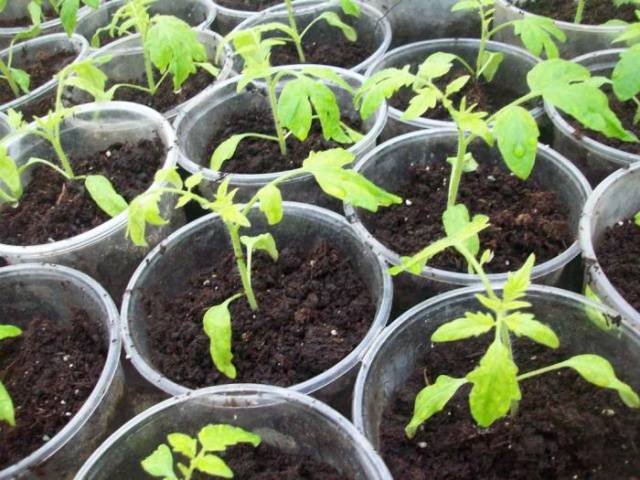

It is much more difficult to deal with mold on seedlings if the reason for its appearance is the wrong soil.
To destroy the mold that has appeared on the soil when growing seedlings, several methods are used.
- Mechanical.
- Chemical.
- Biological.
- People's.
First of all, they start with mechanical removal of mold from the soil in a container or pot in which the seedlings are grown.
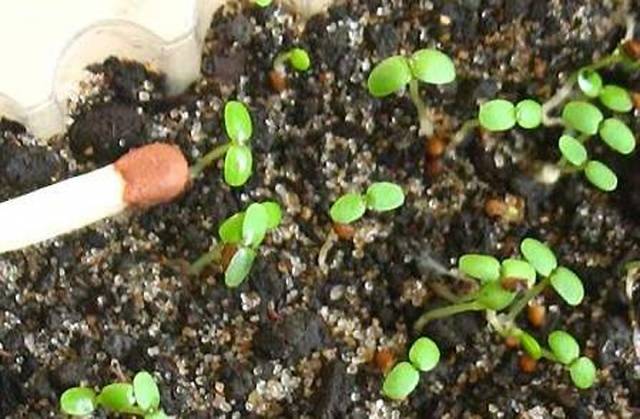

How to mechanically remove mold from seedlings:
The procedure is carried out very carefully.
- With a flat spatula, preferably a wooden one or a toothpick, remove the layer of soil on which mold is visible.
- Instead of the harvested part of the soil, they pour in a new one, otherwise the bare roots will suffer and may die off.
- They dry the soil well, preferably under the bright rays of the sun. The new soil must be thoroughly disinfected so as not to add a new portion of fungal spores with it.
- All collected soil must be removed from the apartment so that it does not become a source of mold spores.
It must be remembered that this method is a temporary measure. Its use only stops the development of molds. If they have already settled in a pot or container, then over time they will appear again and again. But by that time, the seedlings will already grow up, and will be able to fight the fungi on their own.
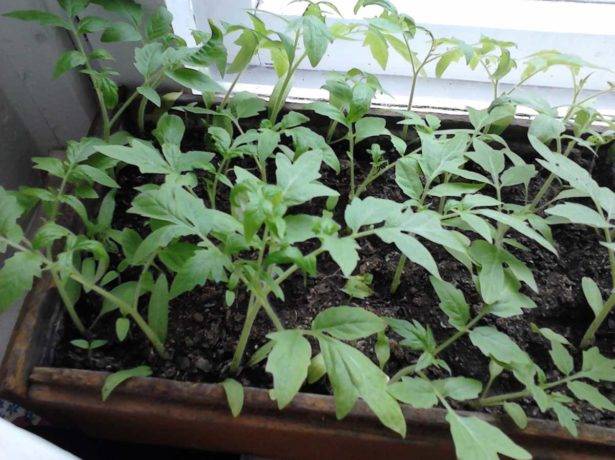

You can additionally protect the top of the soil in the following ways:
- dry soil is sprinkled with wood ash, a fairly thin layer, the benefits of this are double - ash absorbs moisture well and lowers the acidity of the soil, and fungi do not like this very much;
- you can sprinkle the soil with well-washed and disinfected dry river sand, for fungi it is unattractive.
If the mechanical method does not work, and the mold reappears, you should not start all over again. You need to proceed to the next stage and apply chemicals against it. Experienced gardeners advise using Oxyhom, Fundazol for processing. Solutions of these drugs are used instead of irrigation water, usually once. You can do it differently:
- remove mold-affected plants and treat the soil with copper sulfate 3% concentration;
- spray the soil and diseased seedlings with solutions of antifungal fungicides, for example, Quadris, Tsikhom.
If there is no desire to use chemicals in the apartment, you can use biological agents.
Experienced gardeners advise the following biological preparations to combat mold in seedlings: Fitosporin-M, Alirin-B, Gamair-SP, Planriz-Zh. They process seedlings on the 8-10th day of their life. One or even double processing will not give a result. After the first application, it is repeated every 5 days three more times. Together with spraying, the soil is also irrigated with a solution of biofungicide, which is prepared strictly according to the instructions.
There are also folk ways to combat mold on seedlings. What gardeners use if the soil under the seedlings is moldy:
- Once every 2 weeks, water the seedlings with a pink solution of potassium permanganate.
- Activated carbon tablets are crushed and buried in the upper layers of the soil. Charcoal against mold on seedlings can be used in another way: sprinkle the surface of the soil with crushed charcoal. Sometimes crushed charcoal is mixed with sifted ash from hardwood combustion. The proportion is 1: 2.
- When preparing a mixture for sowing seedlings, Shungi Terra fertilizer is added to it. You can powder the surface of the soil with it. Shungite, which is part of the fertilizer, is an effective remedy for all fungal infections.
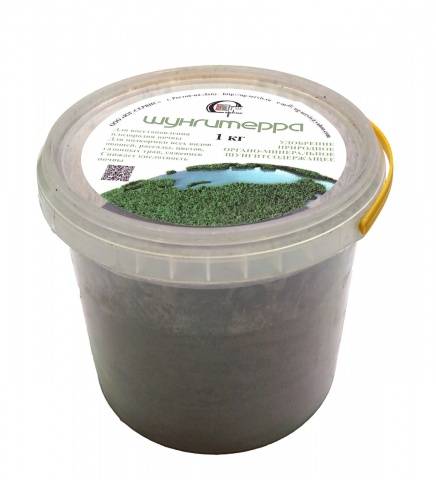

- You can spray the soil with a weak solution of Miramistin.
- Nystatin against mold on seedlings is also a good solution. The tablet is powdered and lightly sprinkled over the surface of the soil.
- Metronidazole against mold on seedlings is used in the form of a solution: one tablet for two and a half liters of water.
- Spraying seedlings with a solution of Nitrofungin helps well - 25 drops are diluted in 0.5 liters of water.
Why mold can appear on seedlings and how to deal with it - all this is described in the video:
Folk methods
Funds from this category will be effective if a white bloom has appeared on a cactus or other plants recently (early stages of the disease) or as a prophylaxis.
- Dissolve 25 g of soda ash and 5 g of liquid soap in 5 liters of hot water. Let the prepared liquid cool. Spray the topsoil and plant with chilled solution 2-3 times. The interval between sprays is a week.
- 1 tbsp. l. baking soda and half a teaspoon. dissolve liquid soap in 4 liters of water. Spray the plant and soil 2-3 times. The interval is 6-7 days.


- Dissolve 2.5 g of potassium permanganate in 10 liters of water. Use 2-3 times. The interval is 5 days.
- Pour 100 g of fresh horsetail with 1 liter of water. Withstand a day. Put on fire and boil for 1-2 hours. Strain, cool, dilute with water (1: 5) and process the bushes. Store the solution for no more than a week in a dark, cool place. Spraying as a preventive measure can be carried out regularly in spring and summer. During the disease (in the early stages), the plants are treated 3-4 times. Frequency - once every 5 days.
- Dissolve 5 g of copper sulfate in 250 ml of hot water. Dissolve 50 g of soap separately in 5 liters of warm water. Pour the solution with vitriol into the soapy liquid in a thin stream, stirring constantly. Spray the plant with the finished product 2-3 times. The interval is 6-7 days.
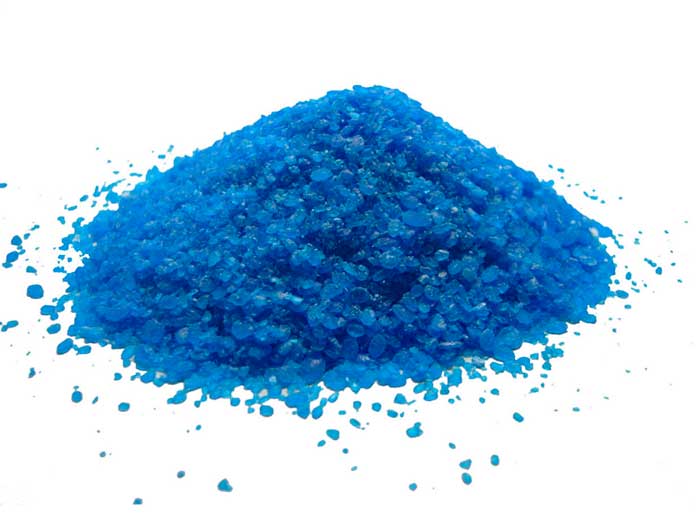

- 1-2 tbsp. l. Pour dry mustard into 10 liters of hot water. Water or spray the plants with the cooled solution.
- Stir 1 kg of ash in 10 liters of heated water. Let the solution sit (3-7 days), stir it regularly. Empty the water into a clean container, add a small amount of liquid soap and pour into a spray bottle. Treat the plants 3 times every day or every other day. The liquid remaining in a separate container, which was drained from the finished product, can be additionally diluted with water and subsequently used for irrigation.
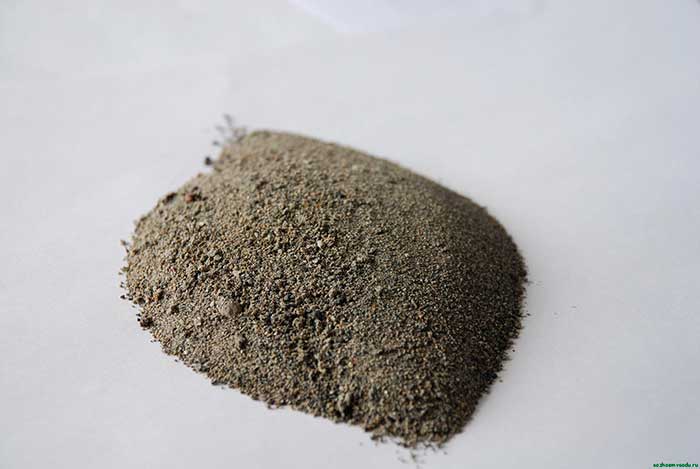

- Fill the rotten manure (preferably cow) with water (1: 3). Let it brew (3 days). Dilute with water in half and spray the bushes.
- Pour 25 g of chopped garlic with 1 liter of water. A day later, when the product is infused, strain and spray the plants.
What to do if peat pots with seedlings get moldy
Many gardeners have already abandoned the use of peat pots for growing seedlings. As practice shows, they very often become moldy. A radical way is to transplant the plant into new soil and into a new container. If this is not possible, you can coat the outside of the pot wall with Fitosporin-M paste, and treat the soil for prevention with any of the methods suggested above.
How to remove mold from petunia seedlings or mold from strawberry seedlings? For this, one of the above methods is suitable. These plants develop slowly at first and therefore require special attention. It is better not to wait for the appearance of mold, but to properly care for the seedlings and carry out preventive treatments.
Why do peat tablets with seedlings grow moldy? If the watering of the plants is moderate, and all other care measures are carried out correctly, this indicates that the peat that was used to prepare the tablets did not mature enough and has an acidic reaction. In this case, it is better not to wait for the death of the plant, but to transplant it into a new soil.
Preventive measures to prevent the appearance of mold
What to do to prevent fungus in flower pots:
- systematically loosen the soil - these actions will provide the lower layers with oxygen and increase the degree of ventilation of the substrate;
- make the drainage system in accordance with the norms;
- contain plants in flower pots, which have holes at the bottom in the required amount and of the appropriate size;
- feeding the soil with activated charcoal or wood ash - this will help improve the ventilation process and protect against infections.
In the absence of signs of infection for prevention the soil should be treated with potassium permanganate... The procedure must be carried out once a month. But too concentrated solution must not be used, this can lead to the death of the plant.
Garlic is another folk remedy. It prevents the development of the fungus. The garlic is cut into several pieces and placed next to the stem of the plant while watering. After the soil is dry, it is harvested.
For prevention, it is recommended to use garlic once a week. For the treatment of the affected land, the frequency of its use is 10-15 times a month.
Types of mold: white, efflorescence
On the surface of the soil in a pot of flowers, there are most often two types of fungi:
- white - very similar to fluff and easy to grind in your hands;
- efflorescence - such a crystalline coating can be white, gray or green.
Efflorescences are more dangerous, since this plaque develops not only on the surface of the soil, but can also affect the inner part of the soil.
How can harm the plant
In addition to the fact that white bloom spoils the aesthetic appearance of the soil and affects it with fungal spores, it also affects the plant itself.
White deposits on the soil surface can cause to the following consequences:
- the flower will stop developing;
- oxygen access will decrease, and the roots will no longer receive useful substances;
- the acidity of the soil will be disturbed and the mineral composition of the soil will change;
- pets can get sick with fungal diseases and perish;
- most often, the plant begins to shed its leaves due to a lack of nutrients in the soil.
As you can see, seemingly harmless white bloom can lead to death. Therefore, you should not start the situation and immediately start fighting mold on the soil surface.
Mold damage
The mold crust looks unaesthetic, but the harm of pathogenic fungi is not limited to this. There are types of mold that cause allergies in people and even provoke the development of cancer.
Due to the fungus covering the soil surface, the plant receives less oxygen and nutrients. The mycelium penetrating the soil will sooner or later provoke root rot.
Therefore, it makes no sense to find out what kind of fungus has infected the soil and how harmful it is. If mold appears in the pot, it must be destroyed.
Tips to Prevent Fungus Infestation
If you monitor the condition of the soil in pots and regularly carry out preventive measures, you can get rid of such a problem as mold, and not only in flower pots. It should always be remembered that it is better to spend some time preventing mold than to put in the effort to fight it. When a plant is properly cared for and quality soil is acquired for planting, the probability of infection is zero. Therefore, you need to monitor humidity, regular ventilation and sufficient lighting. At the same time, you need to make sure that the plants are not in a draft.
When plants are kept in the house, it is necessary to constantly monitor the microclimate, avoiding an excess of moisture.
In the fight against mold, some tips from experienced amateur flower growers can help:
- Buy soil only at trusted retail outlets.
- It is imperative to familiarize yourself with its composition.
- You should not buy heavy substrates, since the fungus spreads in them much faster than in light soils.
- Before planting a plant, it is imperative to decontaminate the soil with the same potassium permanganate, which will reduce the likelihood of the appearance of a fungus.
The maintenance of indoor plants requires a special approach to their cultivation, since this is associated with the rules of cultivation and care, which cannot be violated or simply ignored by organizing care at your own discretion. This approach can lead to unpredictable results, which can be associated with the appearance of mold. If you ignore this fact, then soon only memories will remain from home flowers. The fact is that mold damage to a flower often leads to its death, if you do not try to solve the problem at an early stage.
For some reason, it seems to many housewives that the plants receive little moisture and water them several times a day. After that, after a while they see that the plant begins to die, as its root system has rotted. Naturally, this leads to confusion and misunderstanding of what happened. And the fault is that there is an excess of moisture, although there are plants that love this excess.
»
>
Reasons for the reproduction of the fungus
The occurrence of fungal infections on the ground is associated with certain factors:
- Failure to comply with the rules for watering the plant causes stagnation, leading to an overestimation of the soil moisture rate.
- Watering with cold water.
- Violation of optimal temperature indicators in the room where the flower stands.
- Lack of drainage or too small holes in the bottom of the pot. During watering, they gradually close, which leads to stagnation of moisture in the soil. Mold traces will not be long in coming, they will appear after 2-3 hours.
- Non-conforming soil.
High humidity and insufficient ventilation play a special role in the rapid spread of mold. These phenomena are typical for the period of cold weather, when air currents, penetrating into the room, slow down the processes of evaporation from the poured soil. The liquid stagnates, creating an environment for the growth of fungal colonies. Spores spread intensively in damp houses with basement spaces or imperfect ventilation.
How to prevent mold in pots?
- Loosen the soil regularly, especially after abundant watering;
- Monitor acidity - the right choice of soil during planting and transplanting will minimize the risk of mold;
- Spill even healthy plants with a weak solution of potassium permanganate (potassium permanganate);
- If the substrate is too greasy, add a little sand, it will make the ground less dense;
- Overdry the soil than overflow - excess moisture is the first cause of mold in flower pots;
- Sunbathing would be a good preventive measure, for those sprouts that tolerate bright sunlight well.
Mold in a flower pot, although it can lead to the death of the plant, is not an incurable disease.
It is important in general to maintain moderate humidity in the room, regularly ventilate and monitor the temperature, especially during the off-season.
DETAILS: Why the goat began to give little milk 2019
Keep in mind that mildew is not always present on the surface of the ground. Most often it is limescale, which is formed due to watering with too hard water. It feels like lime, while the mold in the flowerpot is fluffy and damp. You can get rid of limescale by removing the topsoil. If the water runs out of the tap so hard that it leaves a deposit, it must be defended for at least a day before watering.
Operation "Rescue"
In case of single manifestations of mold on the ground, it is enough to stop watering, dry the plant and replace the surface layer of the soil (2-3 cm) with fresh calcined one. Be sure to add medicated charcoal or sphagnum moss to help absorb moisture. Pour with a solution of "Fundazole" (2 g of powder per 1 liter of water).
In case of mass defeat, you can only get rid of mold in flower pots by completely replacing the earth. To do this, remove the plant and set it aside to dry for a day. Rinse the container from residual soil, pour over boiling water, dry well. If the drain holes are too small, enlarge them to avoid blockage again.
Lay a drainage layer of pebbles or crushed bricks at the bottom. Before backfilling, the new soil must be disinfected. Steam in a water bath, ignite in a pan, in the oven, or spill with a solution of potassium permanganate. After planting a flower, pour a thin layer of sand on top or spread expanded clay, which will help to draw in excess moisture.
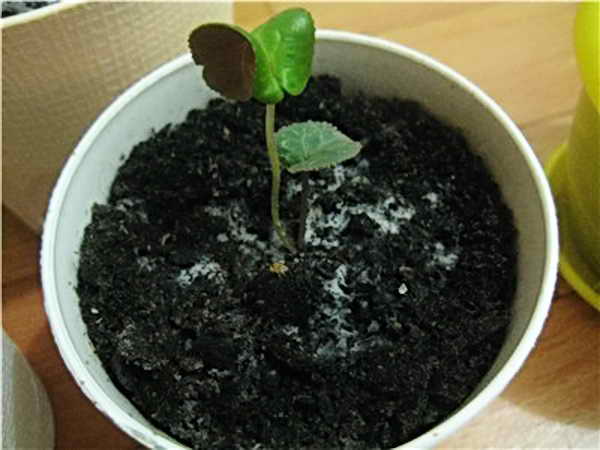

How to get rid of mold
Purchased funds
To combat fungal infection, commercial drugs are used.
- Sarfun 500 sc. It is produced in the form of a concentrated suspension. Manufactured in Poland. Recommended in our country. It is a broad-spectrum fungicide. They can be sprayed on plants. It is especially good to do this during the growing season. It has a healing effect. Can be used for preventive purposes. Safe for shoots and the environment. Has a long lasting protective effect up to four weeks. Does not wash off when spraying a flower. Easy to use. Acts on the parasite, causes a disturbance in the metabolism of fungi a few hours after treatment. The procedure is best done in the morning and evening. When processing, one should try to prevent the drug from getting on the mucous surface and protect the eyes.
- Topsin M. Systemic contact drug, which belongs to fungicides. It is used as a prophylaxis and for medicinal purposes. He copes with fungal infection and parasites: aphids, leaf beetles, lacewing. It is produced in the form of a powder that dissolves well in a liquid. It can also be in the form of an emulsion. The active substance is topsin. In the preparation, its content reaches 70 percent in the powder, and 50 percent in the emulsion. It inhibits the growth of fungal spores. Penetrates the roots. It has a beneficial effect on diseased shoots. Completely infects parasites and blocks their development. After processing, the plant begins to grow well, stretches. The remedy takes effect within the first day. Processing is carried out during the growing season. The plant is re-treated in two weeks. There are analogues of the above-described drugs: fungicite Azofos, Tiovit Jet.
- Azophos. Highly effective product. Actively fights fungal infection. It not only infects fungi, but also provides nutrition for the weakened plant.Nourishes and promotes growth. It contains important trace elements: nitrogen, phosphorus, etc. It resembles the effect of Bordeaux liquid. Destroys fungal spores.
Note! Topsin M can be habit-forming.
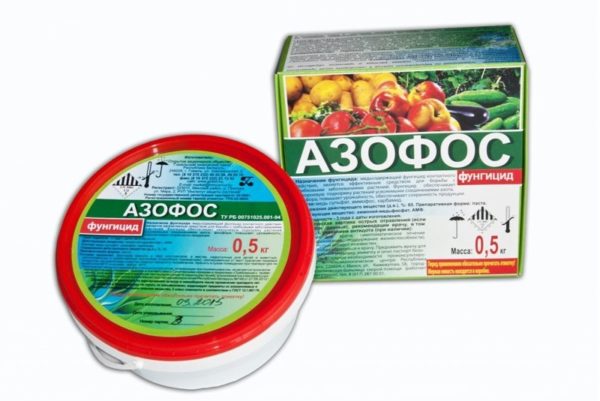

White bloom on the soil in the greenhouse
Very often, owners of greenhouses encounter the appearance of a mildew-white plaque on the soil.
The most common causes of salt formation on the ground in a greenhouse are:
- excessive watering;
- improper ventilation;
- oversaturation of the soil with fertilizers;
- high level of soil acidity.
If the land does not have time to dry out, you need to reduce the intensity of watering. Excess salts that enter the soil with water come to the surface, forming a white crust on it.
If after all the measures taken, the problem remains, you need to pay attention to the place of water intake. It is undesirable to water with water from a well or city water supply. It is better to use pre-collected rainwater or to settle the water in separate containers. This will help reduce soil salting and oxidation.
It is possible to reduce the acidity level using the soil liming procedure or a complete replacement of the top layer.
It is impossible to take any measures to reduce the acidity of the soil during the cultivation of plants, as you can lose the crop. The procedure is carried out only after the harvest.
The greenhouse must have air vents. In the absence of fresh air circulation, water stagnates and the temperature in the greenhouse increases. Moisture evaporation settles on the soil in the form of efflorescence. In addition, high humidity contributes to the development of fungi and parasites. When a fungus is affected, a white sticky plaque settles not only on the ground, but also on the surface of the greenhouse.
Deficiency of sunlight also contributes to the formation of fungus. You can solve the problem with additional lighting using ultraviolet lamps.
Having found a fungus, you should reduce the intensity of watering and ventilate the greenhouse. This will help reduce humidity, stop the development of infection, preventing it from spreading to plants.
To prevent the appearance of fungus the next year after harvest, disinfection is carried out. The soil is disinfected with special means, and the frame and surface inside the greenhouse are washed with soapy water or ready-made disinfectants.
If you still need a transplant of indoor plants
If the above measures did not help, it is possible that the plant will need a transplant.
Dig the flower out of the ground carefully. Treat the roots weak solution potassium permanganate.
The moldy soil should be thrown away and the pot disinfected. If it is ceramic, you can hold it in the oven, or pour boiling water over it. Please note that plastic pots are difficult to decontaminate, and there is a good chance that fungus spores cannot be completely removed from them.
Pour a few centimeters of drainage at the bottom of the pot - you can buy it at specialty stores such as Priroda. The drainage should be followed by soil, also purchased from the store (give preference to "light" soils, with a lot of peat).
Then plant the plant.
And remember that from now on you will water it much less often than before.
The soil in the seedling box is moldy
This is also interesting: How to clean the washing machine from black mold and eliminate the nasty smell?
Another problem that can be encountered in the spring is the appearance of mold in the seedling box.
Freshly planted seeds want to water more often, in addition, many people stretch plastic bags on boxes with seedlings, or cover boxes with glass to create a greenhouse effect.
As a result, young plants get sick. Moreover, such a tendency is noted. Tomatoes and peppers, which have already grown a little, do not take mold. It is the seedlings that suffer, and they are the hardest to help.... Tiny plants have not yet passed the pick, they are at a short distance from each other, their roots are thin as strings.
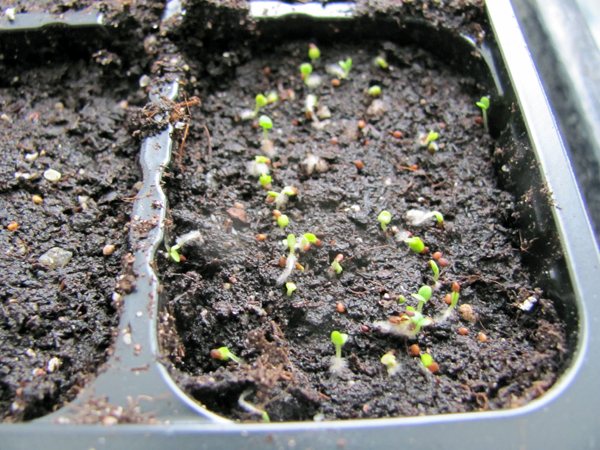

What can be done in this case
Amateur vegetable growers are advised to do this. First of all, you need dry the soil... Remove plastic or glass from the box, place the seedlings on a windowsill, illuminated by the sun. You just need to make sure that the earth does not dry out, otherwise the seedlings may die.
When the soil is dry a small layer of ash should be scattered on top... This must be done carefully, protecting the plants so that the ash does not stick to them. You can use a teaspoon, brush.
Now watering seedlings should be less often... And when you transplant it - in a larger box or in a permanent place in the garden, try not to use soil that has been affected by mold. To do this, shake each plant slightly so that the soil adhering to the roots crumbles.
Professionals warn: if you notice mold, you can't hesitate, the seedlings may die. The surface of the soil should be mulched regularly, every 2-3 weeks. It is best to use a mixture of charcoal and ash.
If you store land for seedlings in the fall, taking it from your garden or the nearest forest, such the soil should be pre-treated, watering abundantly with water with potassium permanganate, and drying. You can add river sand to the soil, as well as a mixture of humus with leafy soil.
- When watering seedlings, experts recommend using the water obtained as a result of melting snow. Or scoop it up from the aquarium.
- If the soil continues to be covered with white spots, repot the plants. If you use the same box, disinfect it first.
The problem with mold in pots needs serious attention. The question of how to get rid of this resistant fungus worries many. remember, that the appearance of mold does not mean that your favorite plant will die... The main thing is to immediately start fighting the insidious fungus.
Causes of the appearance and spread of the fungus
There are several reasons why mold appears in flower pots. For example:
- Incorrect watering of plants, due to which liquid stagnates in the pot.
- In conditions of low temperatures and high humidity.
- Watering the plants with cold water.
- The lack of a drainage system in the pot, so the liquid overmoistens the soil.
- Application of contaminated soil.
As a rule, the more humidity and there is no air movement, then these are the conditions for the rapid growth of mold. Mold most often appears in either spring or autumn.
This is due to the fact that the average daily temperature does not allow moisture to evaporate quickly, therefore, an excess of moisture is noted in the pots of domestic plants. And these are the conditions for the rapid multiplication of fungal spores.
In addition, increased dampness in the house also contributes to the appearance of mold in pots with flowers and not only. In a damp apartment, when the ventilation system is poorly functioning and air stagnates in hard-to-reach places, mold may appear here. In addition, the fact of the location of the apartment plays an important role: if a basement room is located under it, where there is high humidity, then this will certainly affect the microclimate of the apartment.
The appearance of mold in pots where houseplants are grown can be viewed as an emergency and as a signal that all measures must be taken to prevent the fungus from spreading further. To prevent this from happening, it is better to think about it in advance. For example:
- From time to time, loosen the upper ball of soil so that it breathes and there is no stagnation of moisture and air.
- When planting plants, take care of a normal drainage system.
- Grow indoor plants in special pots with holes in the bottom.
- Carry out top dressing with wood ash or activated carbon.Don't forget about other things you can do to reduce the chance of mold growing in your flower pots.
For example, you can treat the soil with potassium permanganate at least once a month. In this case, a weak solution should be prepared that cannot harm the plants.
Garlic is considered a fairly effective remedy against fungus, which must be cut into several pieces and placed next to the stem. This is done before watering, and when the top ball of soil is dry, the garlic is harvested. It can be used in turn once a week. If mold appears, then garlic is applied every two days.
Why the enemy does not sleep
Mold in flower pots appears in favorable conditions, namely:
- Frequent watering. The accumulation of water creates increased humidity - an ideal environment for the growth of fungus.
- Cold, in which the earth does not have time to dry out.
- Lack or poor quality drainage system. Small holes in the pot are clogged and prevent excess moisture from escaping. Lack of a drainage layer (expanded clay, pebbles).
- Contaminated soil.
- Watering with cold, not settled water.
- Insufficient ventilation of the room.
Most often, the appearance of mold in flower pots can be observed in spring and autumn, when there is no heating, it becomes cool in the room and the soil in deep layers dries out slowly. Ideal conditions for the development of fungal infections.
In summer, with high humidity, midges appear over flower pots.
Prevention of the earth against white plaque (mold)
Fighting a fungus in a flower pot is not always easy, it takes more than one day, it happens that a week is not enough. Therefore, it is always easier to prevent infection than to cure it later.
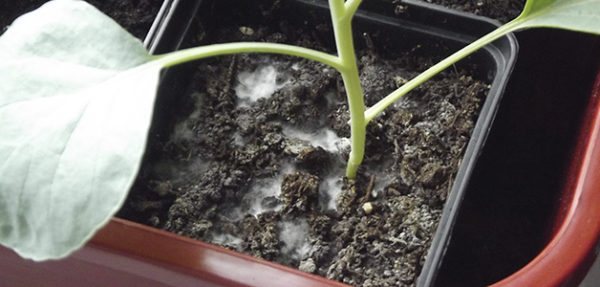

Preventive measures:
- Constant loosening of the soil, especially after watering. This will provide additional air intake and evaporation of excess moisture.
- Providing good and reliable drainage. This is one of the main conditions for planting a flower. It is important that it allows water to pass through well.
- The correct selection of pots or pot. The planter must be selected depending on the shape and location of the roots.
- Feed regularly. Good quality fertilizers will help the plant withstand stress.
- Monthly treatment with a weak solution of potassium manganese. Potassium permanganate will disinfect the soil.
- Ventilation of premises. Plants need daily airing of the room, but this does not mean at all that it is necessary to arrange drafts.
- Creation of an optimal level of humidity.
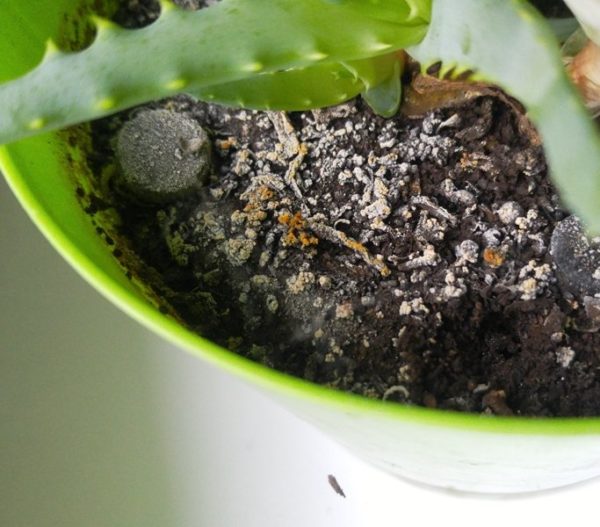

By following simple and simple tips, you can prevent the appearance of white bloom and fungi such as mold.
Varieties of mold
Faced with such a problem as mold in a flower pot, how to get rid of it depends on its type and the reasons for its occurrence.
Black mold
Black mold occurs due to high humidity. It can have various shades.
When this type of mold appears, you should immediately begin the process of getting rid of it, since she is the most dangerous to humans... Interaction with it can lead to an allergic reaction and respiratory failure.
White types of fungus
White mold often appears in soil, trees and plants. The most common species that predominantly appears in flower pots.
In appearance, this fungus is similar to salt stains. They differ in structure. Salt deposits represent microcrystalline formations that do not lose their shape. Mold is easily rubbed in the hands.
Efflorescence
If a bloom is seen on the soil in the form of white, grayish or green spots, then it may be efflorescence - the result of chemical reactions, it has nothing to do with mold. It negatively affects not only the outer part of the soil, but also penetrates into the inner layers.
What is the danger of fungus
Mold disrupts the environment inside the soil, indoor flowers do not receive additional nutrients, the roots rot due to lack of oxygen.The plant begins to hurt and dies.
If there is even a hint of mold on the surface of the earth in a flower pot, immediately get rid of it before it spreads further.
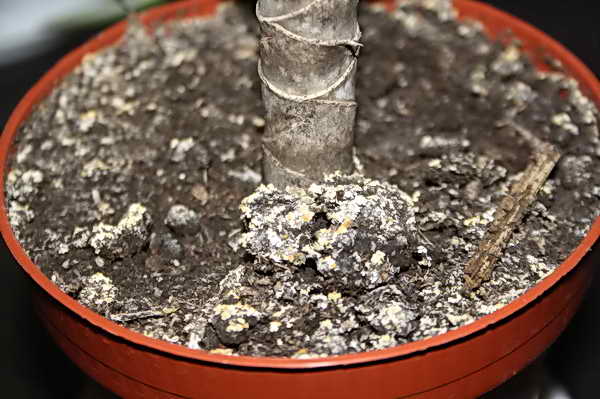

Chemicals
It is recommended to eliminate white bloom (in a neglected state) on the leaves of petunia and other similar plants using special anti-fungus agents.
Spraying is carried out 2-4 times. The interval between them is 7-10 days (depending on the selected drug).
The most effective drugs:
- Fundazol;
- Amistar Extra;
- Topaz;
- Speed;
- Previkur Energy;
- Vitaros;
- Acrobat MC.
Quite often, white mold appears on the ground in flower pots, although its color can be different. As a rule, it appears either under the influence of external factors, or due to improper care of indoor plants. A white bloom appears first at the border of contact between the soil and the pot, and then quickly fills the entire space.
This may be due to the fact that there are spores of fungi in the air, which, under certain conditions, begin to multiply rapidly, growing into whole colonies. This is dangerous not only for the plants themselves, but also for the people living in the apartment.
Change of scenery as a way to save the plant
If changing the watering regime does not bring an effective result, the mold in the flower pot can be defeated in another way. First of all, the plant should be transplanted into a smaller vessel. If the root system does not allow this, then you can only replace the topsoil. Before transplanting, it is recommended to thoroughly wash the pot and scald it with boiling water. Ideally, boil it completely in a saucepan or bucket for a while. Then you need to dry the vessel, pour drainage material on its bottom. In order to get rid of microorganisms that form mold in a flower pot, the new soil must be calcined on a stove or steamed over boiling water before planting a plant. This rule also applies to soil purchased from a specialized store, since it can also be contaminated, which means that it requires processing. For steaming, the soil can be placed in a colander over boiling water.
How to defeat mold on earth?
The most obvious and simple option is to remove the top layer of soil and fill in new soil. Better to completely change the soil in the pot. Spill the substrate with a weak solution of potassium permanganate to kill the fungal spores, or with foundationol (fungicide; handle with care, toxic). Sometimes, to refresh the earth, it is spilled with a weak solution of citric acid or diluted lemon juice.
A popular folk way to get rid of mold in flower pots is to bury peeled garlic cloves in the top layer of the soil. When watering, the juice of garlic, together with water, will penetrate into the deeper layers of the soil and contribute to disinfection.


As a bactericidal agent, it is recommended to use pieces of charcoal or dried moss, which are also mixed with the ground.
Why is mold dangerous?
Mold is considered quite dangerous for the plant, therefore, it should not be allowed to actively fill the space in the pot, and here's why:
- The plant is sick because mold blocks the access of nutrients to the stems, leaves and flowers.
- The access of oxygen to the root system is also blocked.
- Mold can provoke the appearance of various diseases.
- Since the soil moisture is higher than normal, the roots of the plant can simply rot.
If you postpone the fight against the fungus indefinitely, then the flower will simply die.
Prophylaxis
Experienced gardeners say it's easier to prevent mold than to get rid of it later. Below are some of the most effective tips for fighting fungus:
- Soil - it is important to constantly monitor the quality of the soil.To prevent the appearance of fungus, experts advise using a purchased substrate: firstly, it is tested for the presence of fungal microorganisms; secondly, in the store you can buy soil for a specific type of plant. For additional protection of the soil, it can be covered with gravel or expanded clay.
- Pot - it is better to give preference to ceramic products. Their main advantage is their porous structure, which creates the necessary conditions for normal ventilation. Experienced gardeners recommend minimizing the use of plastic and metal pots.
- Drainage - only good drainage can prevent water stagnation. Drainage material can be purchased at specialized hardware stores. Alternatively, you can use pieces of brick or gravel. It is important to loosen the soil regularly to prevent the formation of a hard crust and improve moisture circulation in the soil.
- Watering - you need to know which watering regime is suitable for a particular plant, and strictly follow it. Some varieties of flowers do not tolerate excess moisture well and may begin to rot.
- Disinfection - Before using the substrate, it must be disinfected by processing with high temperatures. There are several processing options: you can heat the soil on a baking sheet in the oven or steam it over boiling water. Some gardeners additionally water the soil with a weak solution of potassium permanganate, and immediately before using the substrate, they add activated carbon to it.
- Conditions - it is important to create optimal conditions for the plant. First of all, you need to take care of a sufficient amount of sunlight, because, as you know, the sun's rays also kill the fungus. No less important conditions are normal humidity and the absence of drafts.
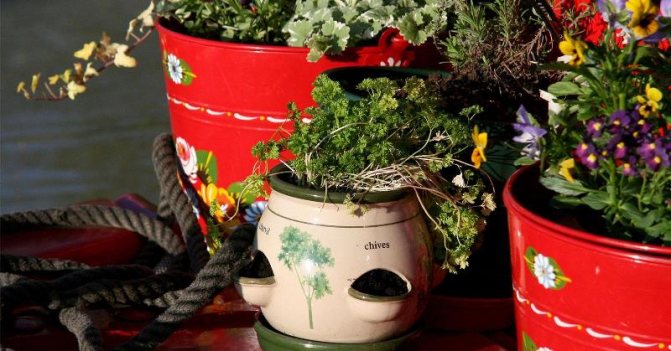

By observing all of the above recommendations, you will permanently protect your plants from infection with fungal diseases.
Preventive measures
In order not to expose plants to tests in the form of molds, midges or souring of the substrate, it is necessary to follow some rules in caring for the soil in flower pots and regularly resort to prevention.
Preventive measures include:
- Regular, but not over-watering.
- Choosing a pot according to the size of the plant.
- Good drainage, which is sized according to the size of the holes in the pot, so that they do not become clogged.
- Regular loosening of the soil for normal oxygen access and fluid seepage to the lower layers of the substrate.
- Soil cultivation with a weak solution of potassium permanganate 1 time per month.
- Systematic ventilation of the room in which the plants are located, maintaining the optimum temperature and humidity.
- Using quality soil, which is sold in specialized stores and packed in factory bags.
- Disinfection of purchased soil before planting a flower with potassium permanganate.
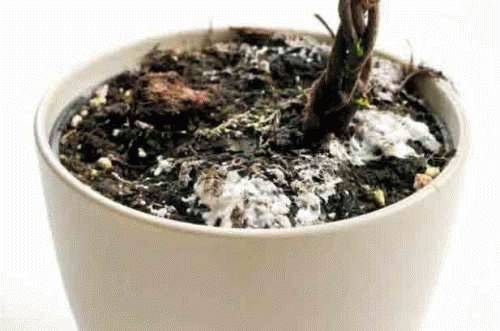

Thus, the appearance of mold, white bloom, an unpleasant odor or midges in the soil of flower pots are directly related to improper plant care. In order to avoid unpleasant consequences, it is important to take into account the peculiarities of flower care and observe preventive measures, and in case of any problem, immediately act to keep the plant healthy.
Plaque on dry ground in flowers
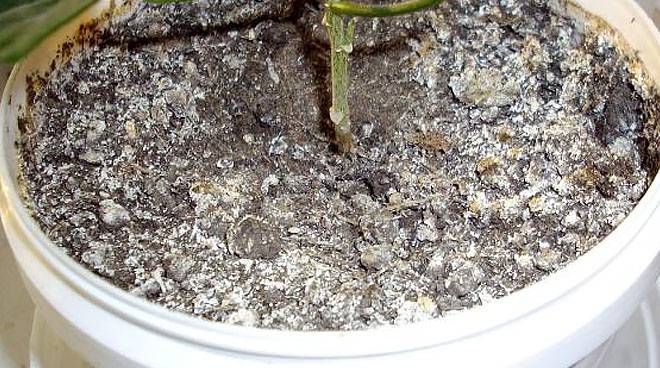

When this plaque appears, the flowers will develop poorly and, if nothing is done, they will eventually die. A white dry layer forms on dry soil due to various factors, one of which is hard water.
Hard water
If you water your indoor flowers with tap liquid, then most likely you will have a problem with white bloom. This is due to the fact that tap water is hard, and there are several ways to soften it:
- Boiling
- Freezing
- Special means
If you do not want to bother with softening the water, rain or melt water (snow) is suitable for watering potted flowers. Collect the rainwater in a clean container and use it to water your plantings.
How to soften water for irrigation
As mentioned earlier, you can use one of three methods to soften the water.
Boiling
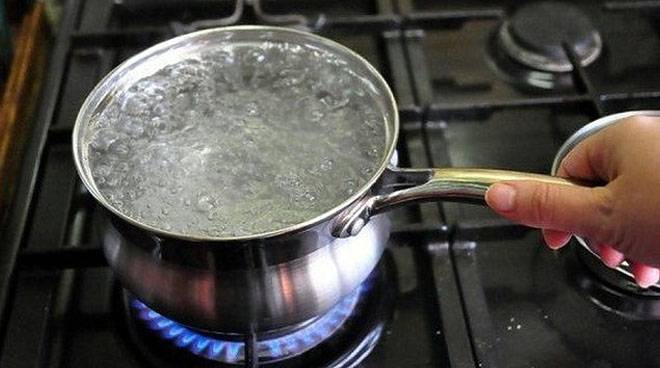

To do this, you need to boil the water and let it settle for a day. Pour water into a container for irrigation, and remove the sediment. Plants can be watered with this liquid, but some experts do not recommend doing this. after boiling, the water loses oxygen and this will not benefit the plants. But such a liquid cannot bring much harm either, so you can use this method if there is no other way out.
Freezing
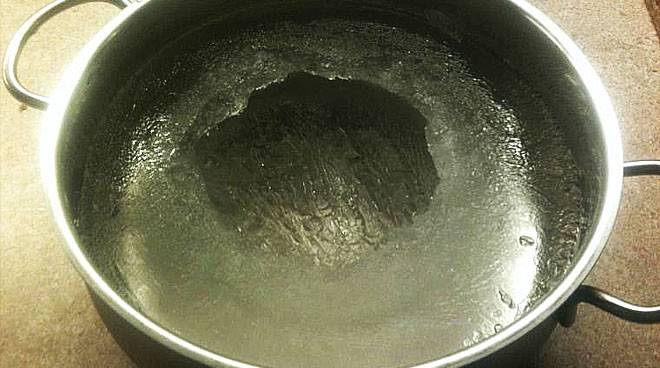

The white layer is the remnants of the salt that is present in the water, they also make the water hard. To remove them, you can freeze the water. Because salt crystals and water crystals have different freezing temperatures, then when we freeze hard water, water first freezes, and only after it is salt. Therefore, as soon as the water has turned into ice, we take it out, and drain the rest of the water in which the salt remains. We defrost the ice and water our potted flowers with it.
Special means
To do this, go to your garden store and buy a water softener. Use this product to soften the water. After using the product, it is better to let the water settle. For the best water softening, follow the instructions on the package. If there is no instruction on the package, you need to buy a good product where there is an instruction.
Other causes of whiteness on earth
The heavy texture of the soil in the pot contributes to the appearance of a white layer. In this case, there is a high capillarity of the soil. The water comes out to the surface of the soil and evaporates, leaving behind salt residues. The same thing happens when the flower pot is too large. You water the soil a lot to moisten the entire perimeter of the pot, but the vegetation cannot absorb that much water, and it eventually evaporates on the soil surface and leaves a light layer. The rapid evaporation of water on the soil surface is affected by dry air in an unventilated room.

